Ever wondered about the vibrant, lush world hidden beneath the towering canopy of tropical rainforests? Brace yourself for a wild ride as we delve into the mesmerizing universe of tropical rainforest plants. With their unique adaptations and stunning diversity, these green giants are the backbone of one of Earth’s most enchanting ecosystems.
Tropical rainforest plants are a kaleidoscope of life, a symphony of shapes and colors that dance to the rhythm of nature. From the ground-hugging moss ferns to the majestic towering trees, each plant plays a crucial role in maintaining the delicate balance of the rainforest ecosystem.
Characteristics of Tropical Rainforests
These green wonderlands are characterized by high temperatures, abundant rainfall, and constant humidity. The thick canopy overhead creates a microclimate where sunlight filters through, creating layers of vegetation. It’s like a multi-tiered cake, with each layer hosting its own unique set of plants adapted to the specific conditions of that level. This layered structure is not just a visual treat but also a survival strategy, allowing different species to coexist in harmony.

Tropical rainforests are scattered across the globe, with the Amazon, Congo, and Southeast Asia standing out as biodiversity hotspots. The Brazil Nut Tree, native to the Amazon rainforest, produces delicious nuts and holds cultural significance for indigenous communities. These plants aren’t just greenery; they are woven into the cultural fabric of the people who call these rainforests home. Medicinal uses, food sources, and traditional rituals intertwine with these vibrant ecosystems’ botanical tapestry.
The Plants of the Tropical Rainforest
Now, let’s meet the stars of the show – the plants. The tropical rainforest boasts an astonishing variety of flora, from the ground-dwelling ferns to the towering emergent trees. Orchids, with their intricate blooms, add a touch of elegance, while the rubber tree, with its economic significance, anchors the forest floor. Lianas, those adventurous climbers, wrap around trees, forming living bridges between the levels. Like a character in a play, each plant contributes to the richness and complexity of the rainforest narrative.
Tropical rainforest plants have evolved mind-boggling adaptations in the relentless competition for sunlight, water, and nutrients. Strangler Figs start as epiphytes, wrapping around host trees and slowly taking over. With their vibrant orange-red flowers, Monkey Brush Vines stand out like a brushstroke on a canvas, attracting pollinators in the bustling jungle. These plants aren’t just passive inhabitants; they are strategic players in the survival game of the rainforest. Here are the most popular tropical rainforest plants:
Orchid (Orchidaceae)

- Botanical Name: Orchidaceae
- Mature Size: Varies widely; some are small, while others can be large and epiphytic.
- Bloom Time: Throughout the year, depending on the specific orchid species.
- Leaf Color: Green, sometimes with variegation.
- Flower Color: Diverse colors, including white, pink, purple, and yellow.
- Light: Generally filtered or indirect light.
- Soil Needs: Epiphytic orchids prefer a well-draining orchid mix.
- USDA Hardiness Zones: Varies by species.
Orchids, belonging to the Orchidaceae family, are renowned for their exotic and intricate flowers. They showcase a remarkable diversity in size, shape, and color. Many orchids are epiphytic, meaning they grow on other plants rather than in soil. Their adaptations include specialized roots for clinging onto trees and absorbing nutrients from the air. Orchids have a significant ecological role in the rainforest, contributing to the biodiversity of these lush ecosystems.
Bromeliad (Bromeliaceae)

- Botanical Name: Bromeliaceae
- Mature Size: Varies, from small rosettes to larger plants.
- Bloom Time: Bromeliads can bloom at various times, depending on the species.
- Leaf Color: Green, often with vibrant patterns or variegation.
- Flower Color: Diverse, including red, orange, pink, and purple.
- Light: Prefer bright, indirect light.
- Soil Needs: Epiphytic species grow on trees, while terrestrial species thrive in well-draining soil.
- USDA Hardiness Zones: Varies by species.
Bromeliaceae encompasses a diverse group of plants, including the iconic pineapple. Bromeliads often form rosettes with water-catching structures, creating microhabitats for various organisms. Their unique adaptations include specialized trichomes on leaves for water absorption, allowing them to thrive in the rainforest canopy. Bromeliads play a crucial role in providing habitats and sustenance for various creatures, contributing to the rainforest’s intricate web of life.
Fern (Polypodiopsida)
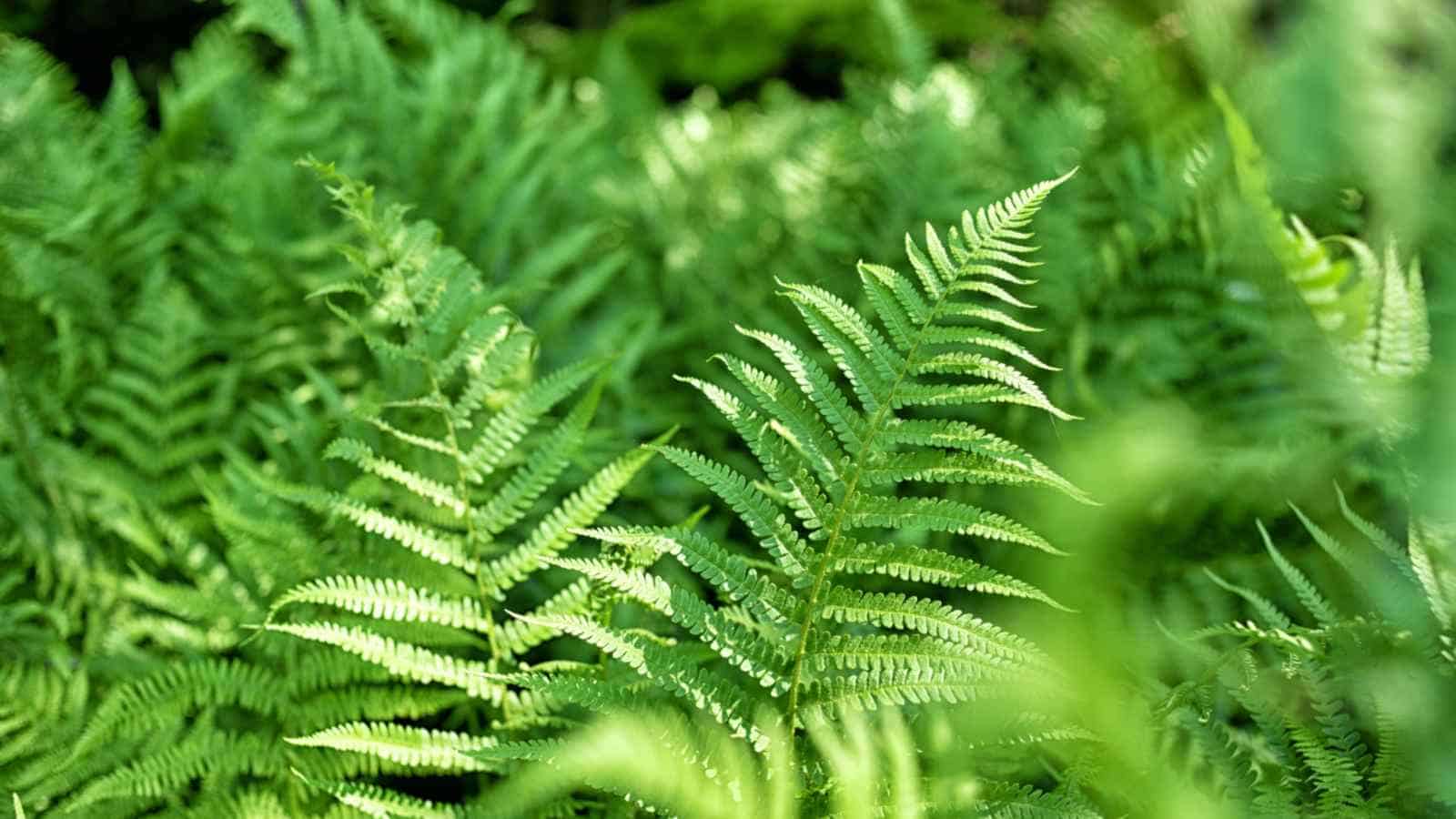
- Botanical Name: Polypodiopsida
- Mature Size: Varies, from small ground-covering ferns to larger tree ferns.
- Bloom Time: Ferns reproduce via spores and don’t produce traditional flowers.
- Leaf Color: Green, with a variety of shapes and textures.
- Light: Most ferns prefer shaded or dappled light.
- Soil Needs: Well-draining soil rich in organic matter.
- USDA Hardiness Zones: Varies by species.
Polypodiopsida, the ferns, are ancient plants that have thrived for millions of years. Their feathery or leathery fronds add lushness to rainforest environments. Ferns often colonize the forest floor, adapting to low-light conditions. They contribute to the rainforest ecosystem by providing habitat and food for various fauna. Gardening enthusiasts appreciate ferns for their unique foliage and adaptability to different growing conditions.
Bird of Paradise (Strelitzia reginae)
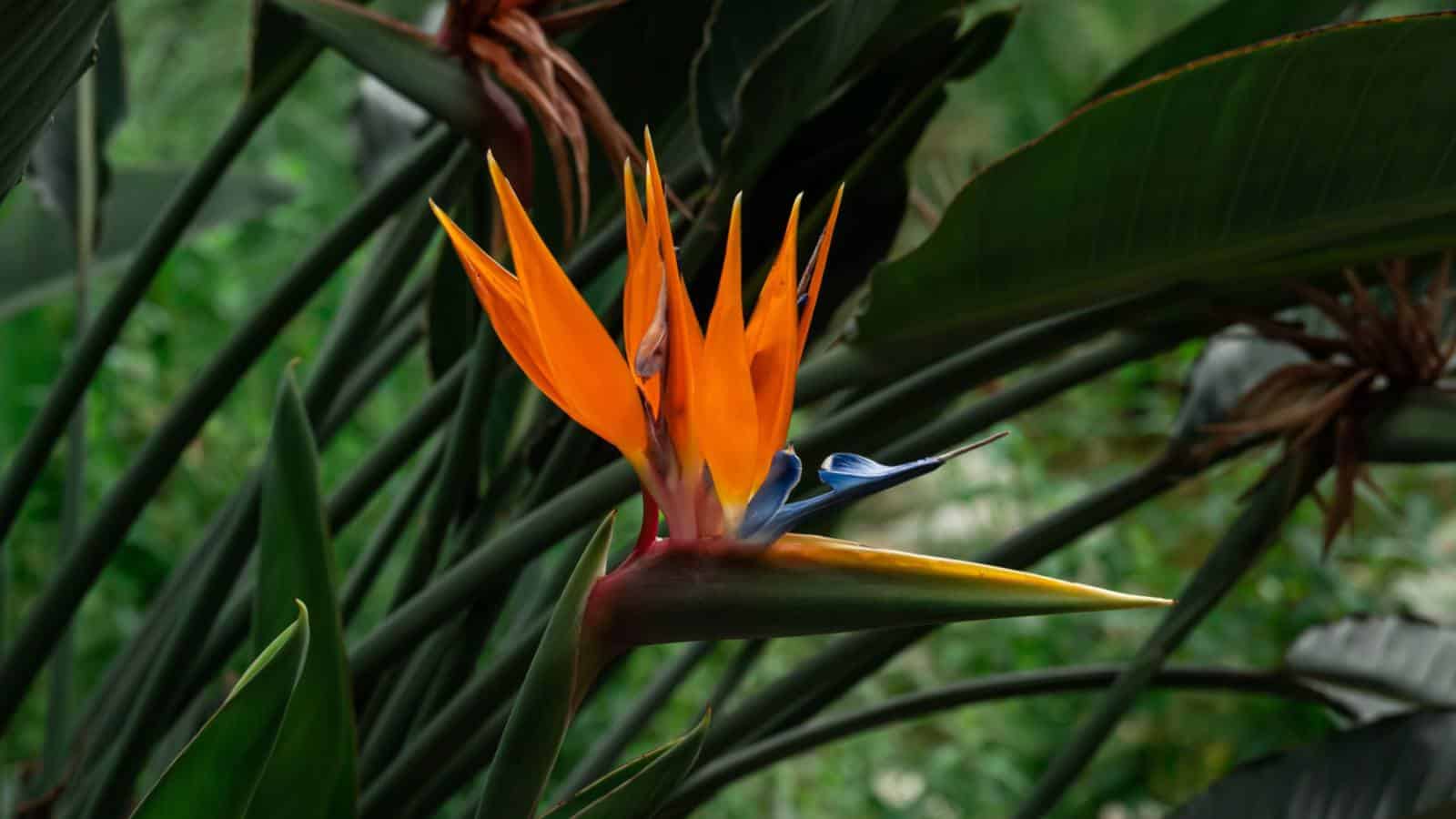
- Botanical Name: Strelitzia reginae
- Mature Size: Up to 5-6 feet tall indoors; larger outdoors.
- Bloom Time: Year-round, with peak flowering in spring and fall.
- Leaf Color: Dark green, banana-like leaves.
- Flower Color: Striking orange and blue.
- Light: Bright, indirect light.
- Soil Needs: Well-draining, fertile soil.
- USDA Hardiness Zones: 10-12.
Strelitzia reginae, commonly known as Bird of Paradise, is an iconic tropical plant known for its distinctive bird-like flowers. The large, banana-like leaves add a touch of the exotic to any setting. Bird of Paradise adapts well to the rainforest biome, thriving in its native South African habitat and becoming a popular ornamental plant worldwide. With proper care, including bright light and well-draining soil, it becomes a stunning focal point in both indoor and outdoor gardens. Its adaptability makes it a favorite in tropical landscapes.
Bamboo (Bambusoideae)
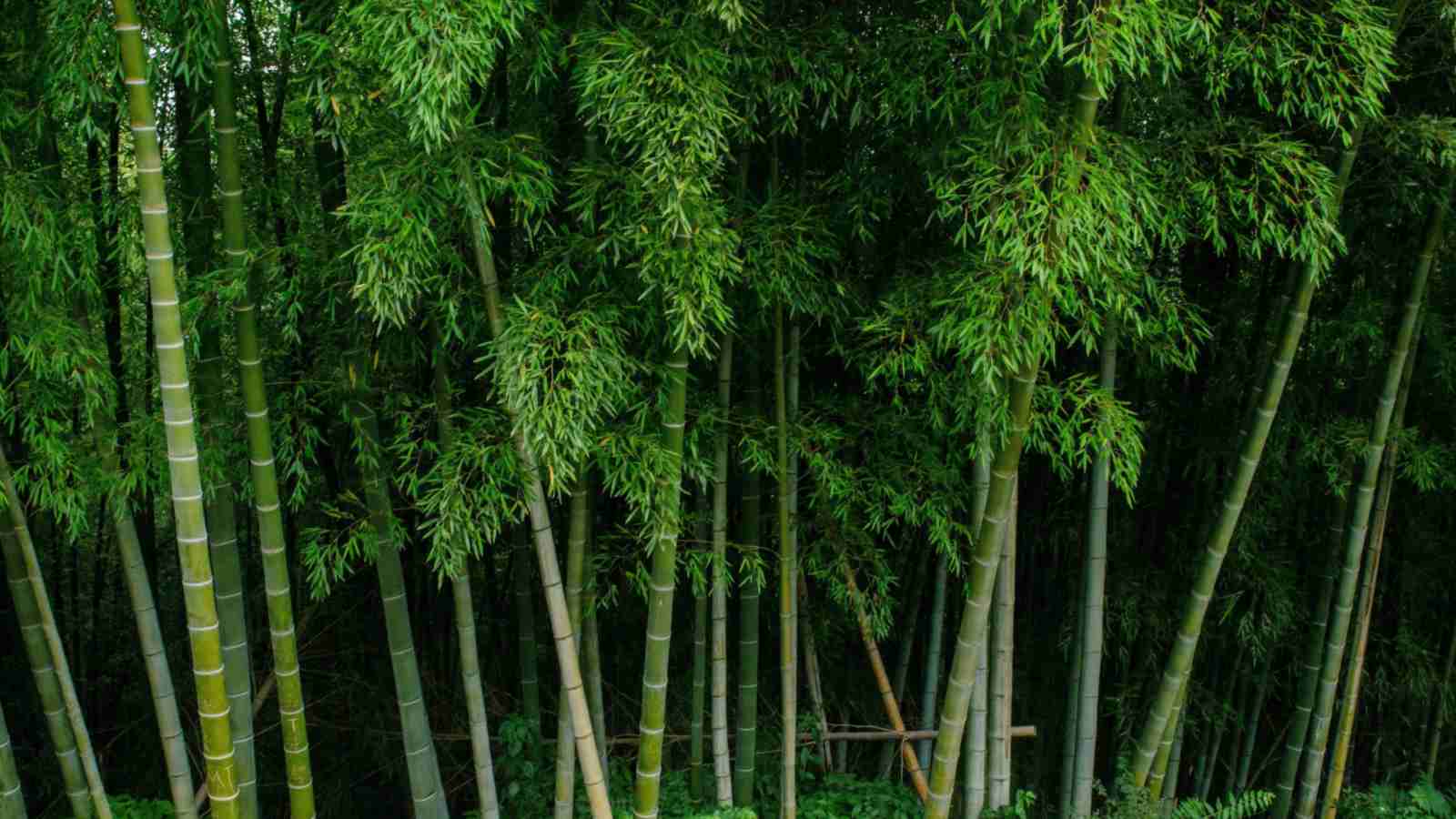
- Botanical Name:Bambusoideae
- Mature Size: Varies by species, from small ornamental varieties to towering timber bamboo.
- Bloom Time: Infrequently, bamboo primarily reproduces through rhizomes.
- Leaf Color: Green, with variations in size and shape.
- Flower Color: Varies; some species produce small, inconspicuous flowers.
- Light: Full to partial sun, depending on the species.
- Soil Needs: Well-draining, fertile soil.
- USDA Hardiness Zones: Varies by species.
Bambusoideae, commonly known as bamboo, is a versatile and fast-growing plant family. Bamboos have adapted to the rainforest environment, forming dense stands that provide habitat and food for various animals. They are known for their rapid growth, making them valuable for erosion control and as a renewable resource. Bamboos are culturally significant in many regions and are used for construction, crafts, and even as a food source. In gardens, they add a touch of elegance and create a serene atmosphere.
Heliconia (Heliconiaceae)
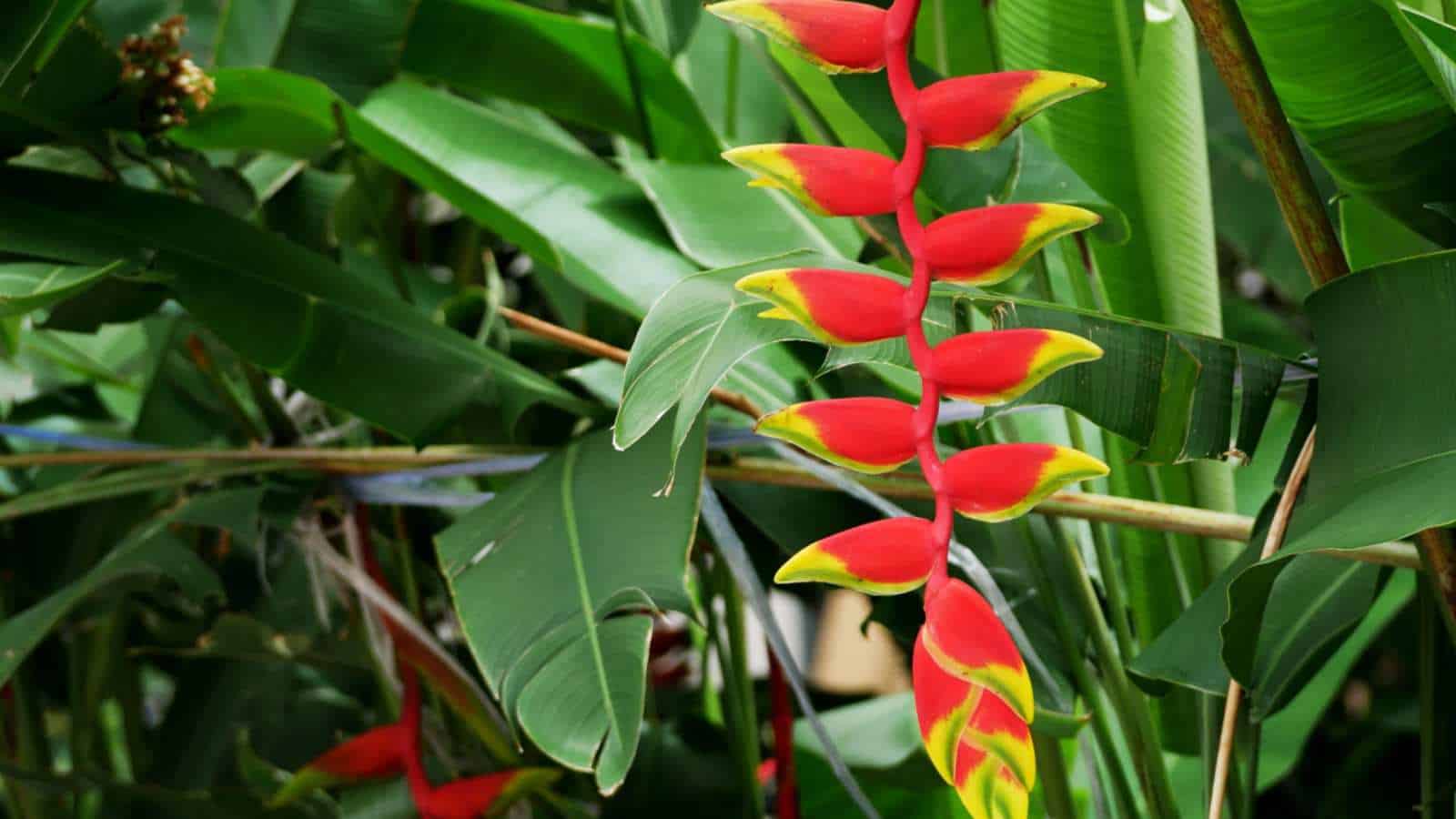
- Botanical Name: Heliconiaceae
- Mature Size: Varies by species; can range from a few feet to over 20 feet in height.
- Bloom Time: Throughout the year, depending on the species.
- Leaf Color: Green to reddish, with different leaf shapes.
- Flower Color: Vibrant, including shades of red, orange, and yellow.
- Light: Bright, filtered light.
- Soil Needs: Well-draining soil rich in organic matter.
- USDA Hardiness Zones: 10-12.
Heliconiaceae, commonly known as Heliconia, is a family of tropical plants known for their vibrant and dramatic inflorescences. These plants have evolved in the rainforest to attract pollinators with their showy flowers. Heliconias are often used in landscaping to add a touch of the exotic. Their adaptation to the rainforest biome includes a preference for humid conditions and bright, indirect light. They play a crucial role in supporting biodiversity by providing nectar for various insects and birds.
Epiphytic Cactus (Epiphyllum)
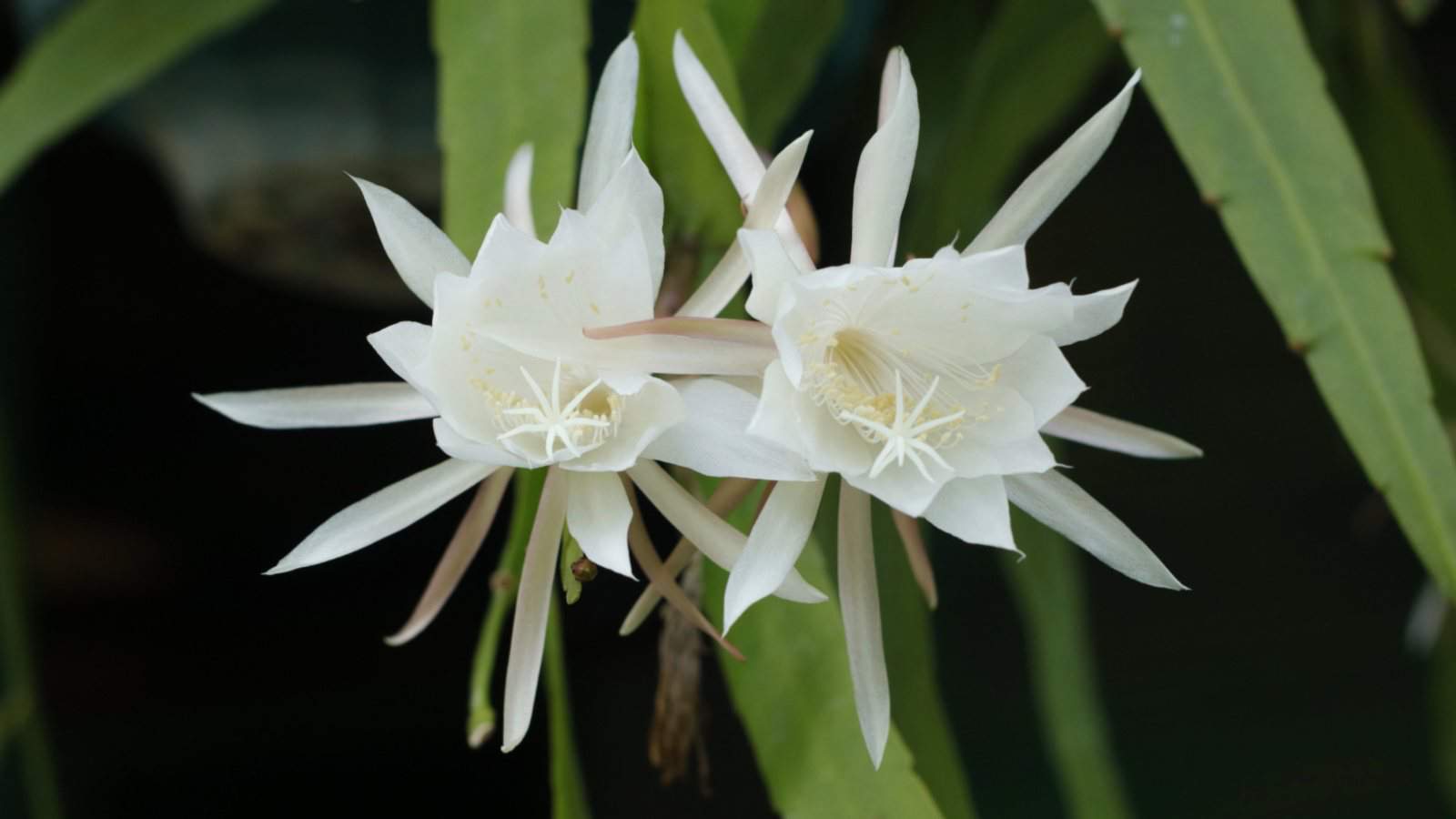
- Botanical Name: Epiphyllum
- Mature Size: Varies by species; can range from compact to trailing.
- Bloom Time: Spring to early summer, with showy, nocturnal flowers.
- Leaf Color: Green, with flattened stems.
- Flower Color: Diverse, including white, pink, red, and yellow.
- Light: Bright, indirect light.
- Soil Needs: Well-draining epiphytic mix.
- USDA Hardiness Zones: 10-12.
Epiphyllum, commonly known as Epiphytic Cactus or Orchid Cactus, is a group of cacti adapted to growing on other plants. With their unique flattened stems and stunning flowers, these cacti add a touch of beauty to rainforest environments. Their adaptations include water storage in thick stems, allowing them to thrive in epiphytic conditions. In gardens, they are appreciated for their low-maintenance care and striking blooms. Epiphyllums are also known for their night-blooming flowers, attracting moths and other nocturnal pollinators.
Pitcher Plant (Nepenthes)
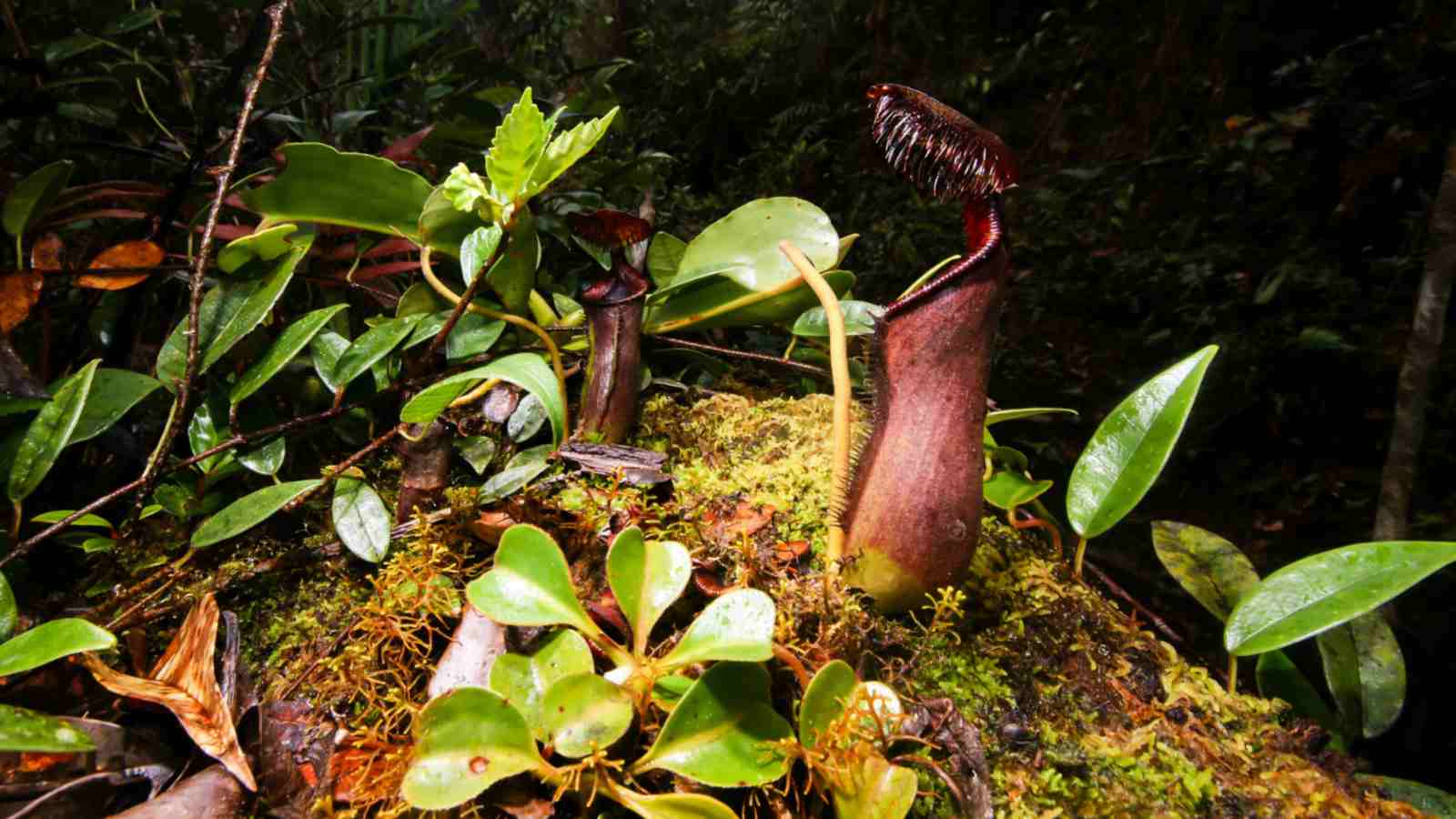
- Botanical Name: Nepenthes
- Mature Size: Varies by species; can range from compact to sprawling vines.
- Bloom Time: Pitcher plants produce unique pitcher-shaped traps rather than traditional flowers.
- Leaf Color: Green to red, with distinctive pitcher-shaped structures.
- Flower Color: Varies; some species have inconspicuous flowers.
- Light: Bright, indirect light.
- Soil Needs: Well-draining, acidic soil.
- USDA Hardiness Zones: Varies by species.
Nepenthes, commonly known as Pitcher Plants, are carnivorous plants with a unique adaptation for nutrient acquisition. The pitcher-shaped traps lure insects into a digestive fluid, providing the plant with essential nutrients. In rainforests, pitcher plants thrive in nutrient-poor soils by supplementing their diet with captured prey. Their unique appearance and ecological role make them intriguing additions to gardens. Proper care involves mimicking their native conditions, including high humidity, bright light, and acidic soil.
Rubber Tree (Ficus elastica)

- Botanical Name: Ficus elastica
- Mature Size: Can reach impressive heights, both indoors and outdoors.
- Bloom Time: Insignificant flowers are grown for their foliage.
- Leaf Color: Dark green, large, glossy leaves.
- Flower Color: Insignificant; grown for its foliage.
- Light: Bright, indirect light.
- Soil Needs: Well-draining soil.
- USDA Hardiness Zones: 10-11.
Ficus elastica, commonly known as the Rubber Tree, is a popular tropical plant appreciated for its bold foliage and air-purifying qualities. Native to Southeast Asia, it has adapted to the rainforest environment by developing large, glossy leaves that efficiently capture sunlight. In gardens and homes, Rubber Trees thrive in bright, indirect light and well-draining soil. They are known for their low maintenance and the ability to thrive in various indoor conditions, making them a favorite among houseplant enthusiasts.
Fishtail Palm (Caryota)
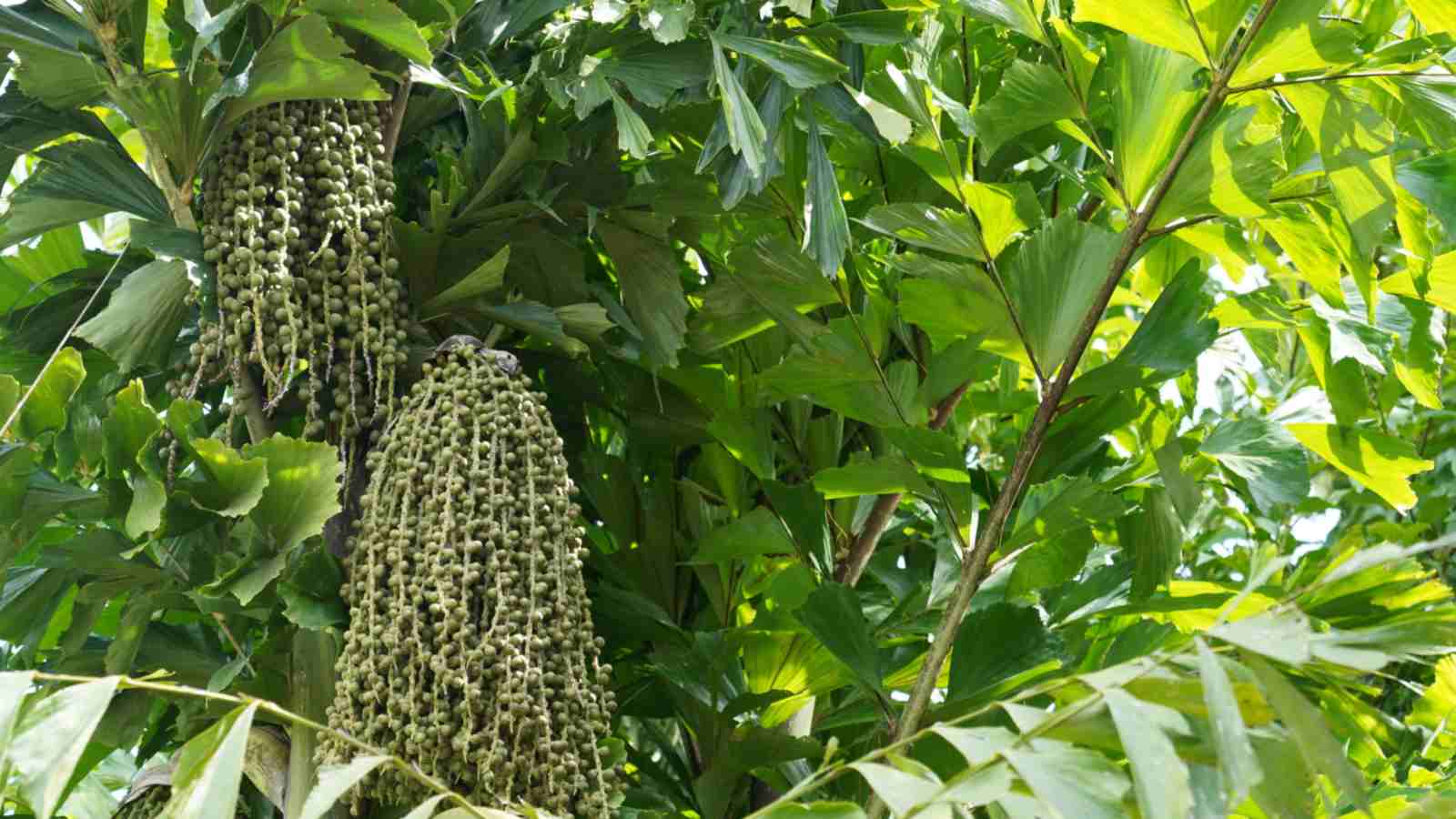
- Botanical Name: Caryota
- Mature Size: Varies by species; can range from small to large palms.
- Bloom Time: Depending on the species, some bloom infrequently.
- Leaf Color: Dark green, unique fishtail-shaped leaflets.
- Flower Color: Inconspicuous flowers grown for its foliage.
- Light: Bright, indirect light.
- Soil Needs: Well-draining soil.
- USDA Hardiness Zones: 9-11.
Caryota, commonly known as Fishtail Palm, is a distinctive palm species known for its unique, fishtail-shaped leaves. Native to Southeast Asia, it has adapted to the rainforest environment by developing a robust and striking foliage structure. Fishtail Palms are popular ornamental plants, adding a touch of elegance to gardens and landscapes. Their adaptability to different light conditions and well-draining soil make them suitable for various tropical and subtropical regions.
Philodendron (Philodendron)
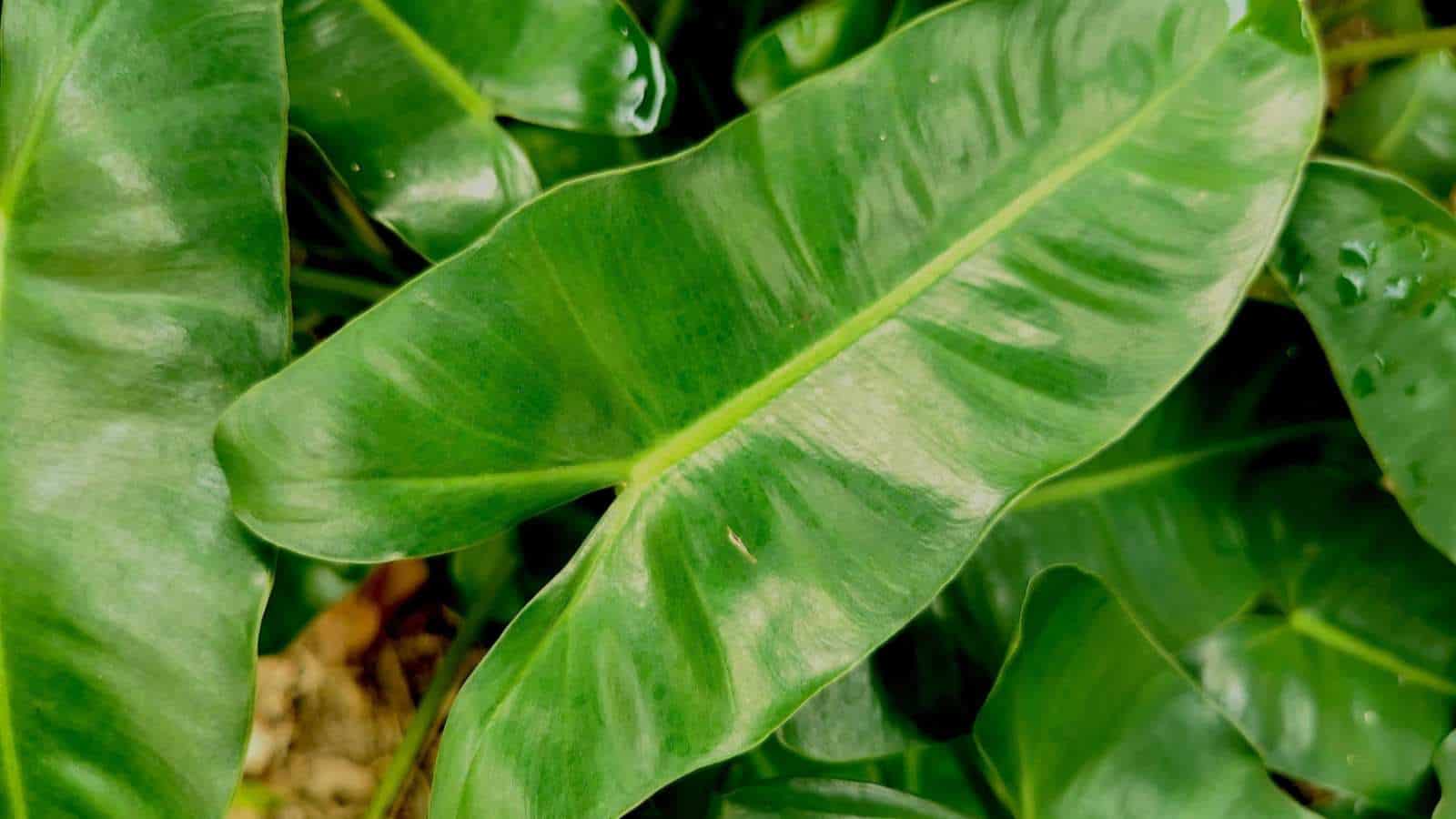
- Botanical Name: Philodendron
- Mature Size: Varies widely, from compact houseplants to large climbing varieties.
- Bloom Time: Inconspicuous flowers; grown for its foliage.
- Leaf Color: Green to variegated, with diverse leaf shapes.
- Flower Color: Inconspicuous flowers; grown for its foliage.
- Light: Moderate to bright, indirect light.
- Soil Needs: Well-draining, organic-rich soil.
- USDA Hardiness Zones: Varies by species.
Philodendron, a genus within the Araceae family, is a diverse group of tropical plants known for their attractive foliage. Their adaptation to the rainforest biome includes climbing habits, allowing them to reach sunlight in the understory. Philodendrons are popular houseplants, appreciated for their low-maintenance care and air-purifying qualities. In gardens, they add lushness and diversity to shaded areas, contributing to the overall aesthetic of tropical landscapes.
Snake Plant (Sansevieria trifasciata)
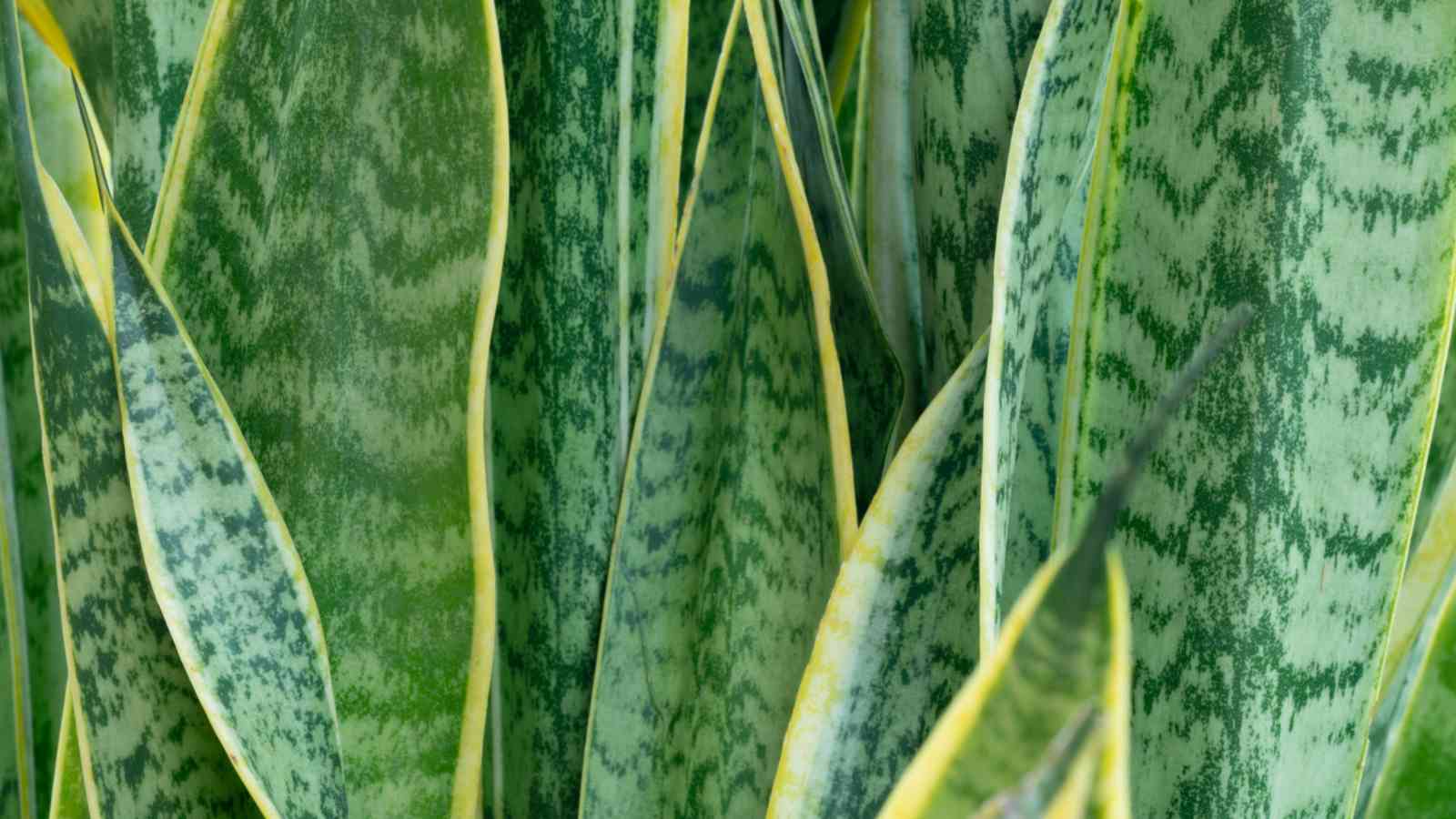
- Botanical Name: Sansevieria trifasciata
- Mature Size: Compact, reaching up to 2-4 feet in height.
- Bloom Time: Rarely blooms indoors; grown for its architectural foliage.
- Leaf Color: Green with variegation, upright and sword-shaped.
- Flower Color: Greenish-white, inconspicuous flowers.
- Light: Low to bright, indirect light.
- Soil Needs: Well-draining soil; adaptable to various conditions.
- USDA Hardiness Zones: 9-11.
Sansevieria trifasciata, commonly known as Snake Plant or Mother-in-law’s Tongue, is a resilient and adaptable tropical plant. Native to West Africa, its upright, sword-shaped leaves have evolved to conserve water, making it well-suited to the rainforest environment. Snake Plants are popular indoor plants due to their air-purifying qualities and low-maintenance care. Their architectural foliage adds a modern touch to both indoor and outdoor spaces, making them a favorite among plant enthusiasts.
Passion Flower (Passiflora)
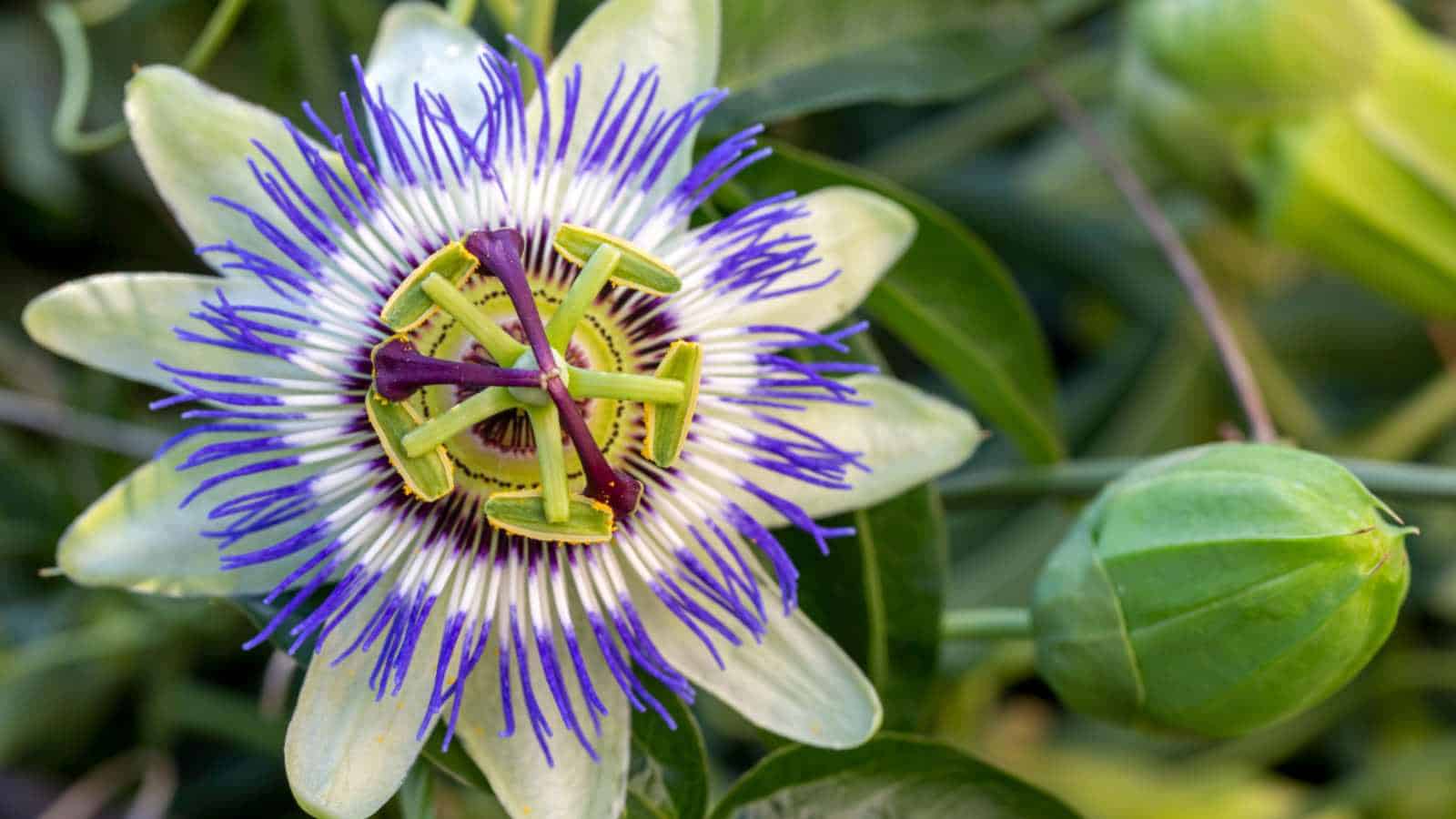
- Botanical Name: Passiflora
- Mature Size: Varies by species; can range from compact vines to large, sprawling plants.
- Bloom Time: Summer to early fall, producing unique and intricate flowers.
- Leaf Color: Green to variegated, with diverse leaf shapes.
- Flower Color: Vibrant and diverse, including shades of purple, pink, and white.
- Light: Full to partial sun.
- Soil Needs: Well-draining, fertile soil.
- USDA Hardiness Zones: Varies by species.
Passiflora, commonly known as Passion Flower, is a genus of vines known for its exotic and intricate flowers. Native to tropical and subtropical regions, Passion Flowers have adapted to the rainforest environment by attracting pollinators with their unique floral structures. Passion Flowers are not only ornamental but also host plants for various butterfly species. Their adaptability to different growing conditions makes them suitable for gardens and landscapes, adding a touch of tropical elegance.
Shampoo Ginger Lily (Zingiberaceae)

- Botanical Name: Zingiberaceae
- Mature Size: Varies by species
- Bloom Time: Infrequent, depending on species
- Leaf Color: Green
- Flower Color: Variable, often vibrant
- Light: Filtered sunlight
- Soil Needs: Well-draining, rich soil
- USDA Hardiness Zones: Varies
Zingiberaceae, the ginger family, includes diverse species with aromatic rhizomes. Shampoo Ginger Lily plays a vital role in rainforest ecosystems, providing food for various animals and contributing to the overall biodiversity.
Fiddle Leaf Fig (Ficus lyrata)
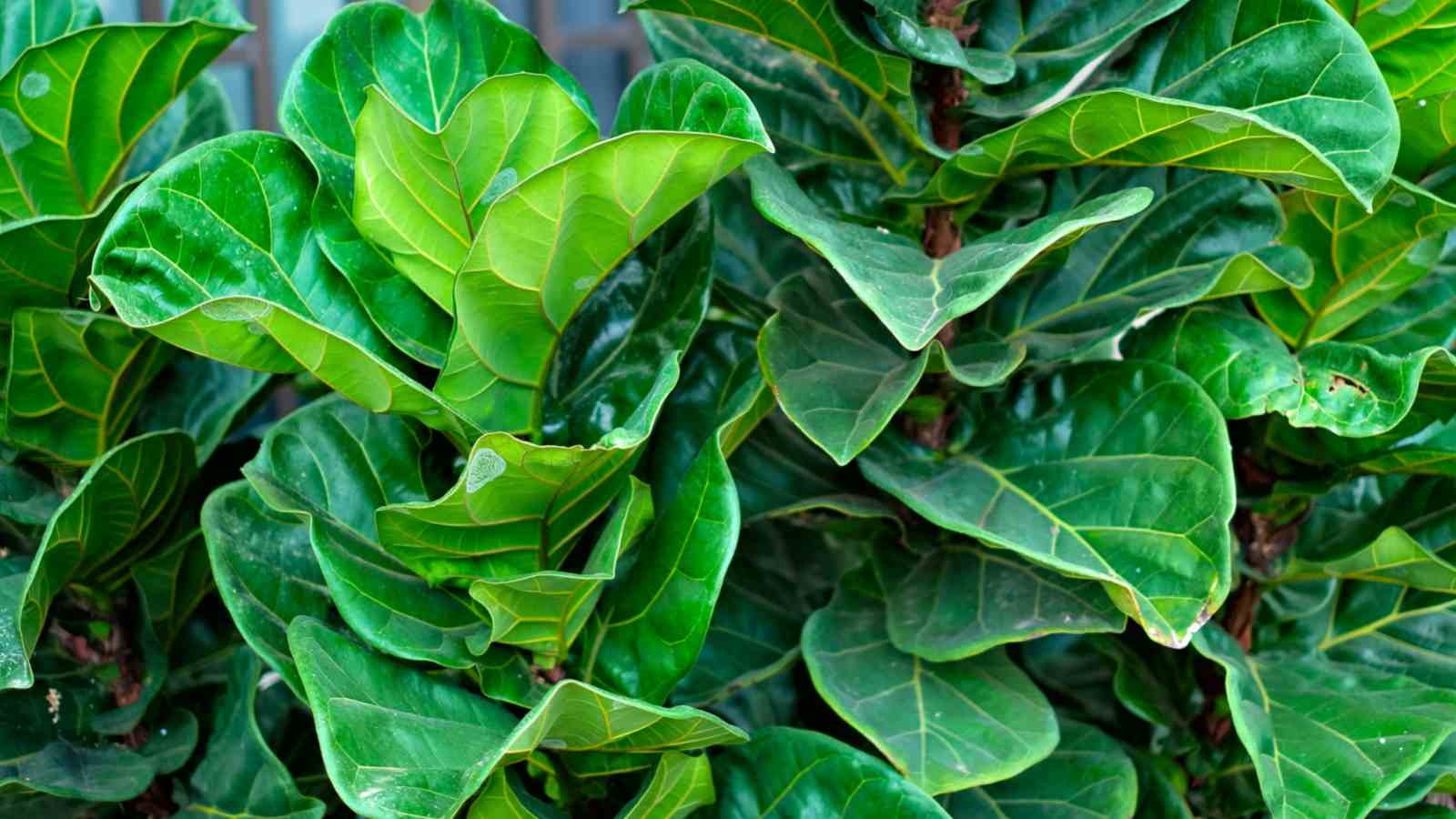
- Botanical Name: Ficus lyrata
- Mature Size: Up to 10 feet tall indoors
- Bloom Time: Rarely flowers indoors
- Leaf Color: Dark green, fiddle-shaped
- Flower Color: Inconspicuous
- Light: Bright, indirect light
- Soil Needs: Well-draining, fertile soil
- USDA Hardiness Zones: 10 to 12
Ficus lyrata, the fiddle leaf fig, is an iconic rainforest plant with large, violin-shaped leaves. Its adaptability to indoor conditions reflects its resilience in its native rainforest habitat.
Alocasia (Alocasia)
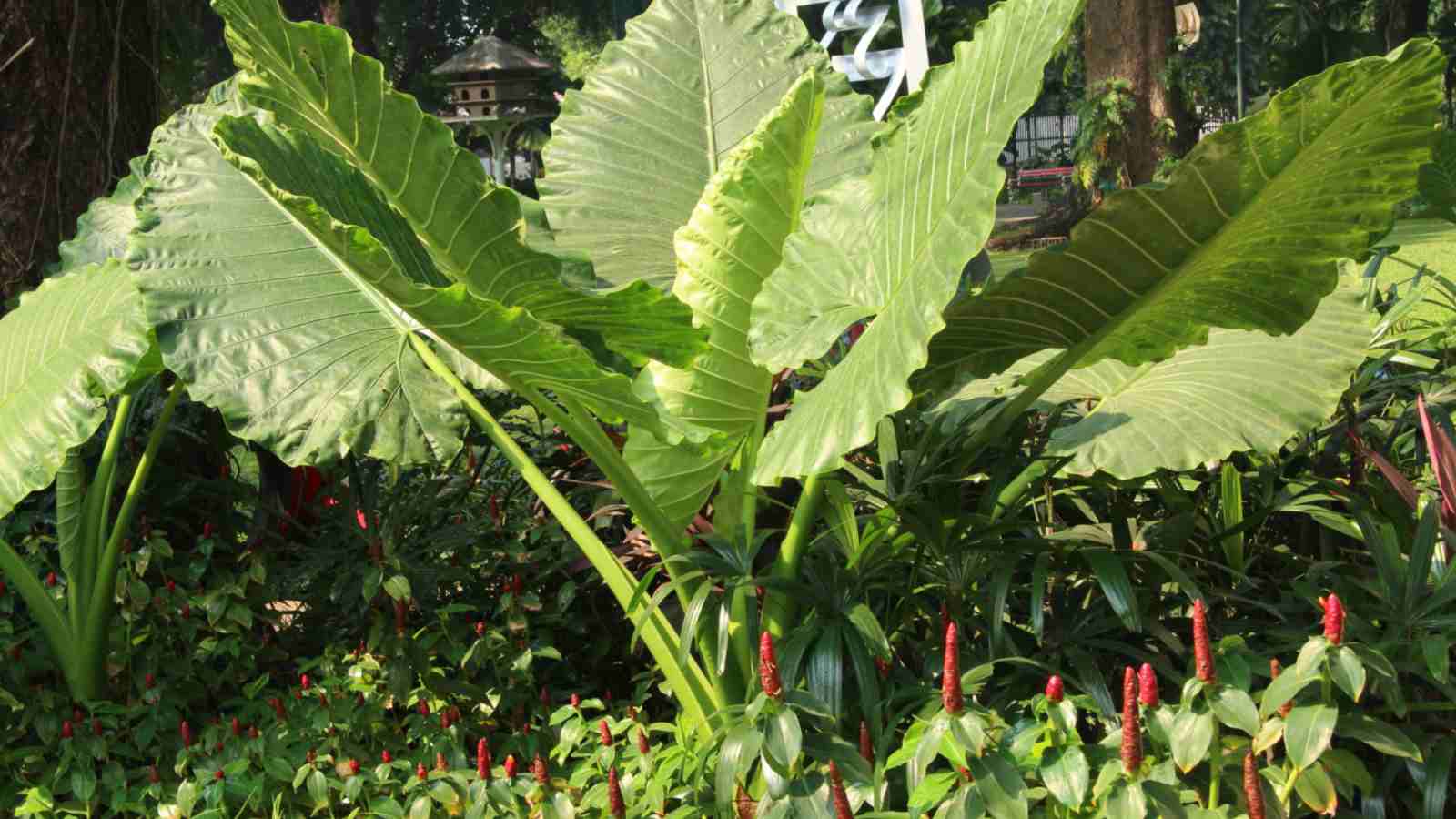
- Botanical Name:Alocasia
- Mature Size: Varies by species
- Bloom Time: Infrequent and not the main feature
- Leaf Color: Green with distinctive patterns
- Flower Color: Inconspicuous
- Light: Bright, indirect light
- Soil Needs: Well-draining, rich soil
- USDA Hardiness Zones: Varies
Alocasia species, known for their large, dramatic leaves, are well-suited to rainforest understories. Their unique foliage and impressive size contribute to the biodiversity of these ecosystems.
African Violet (Saintpaulia)
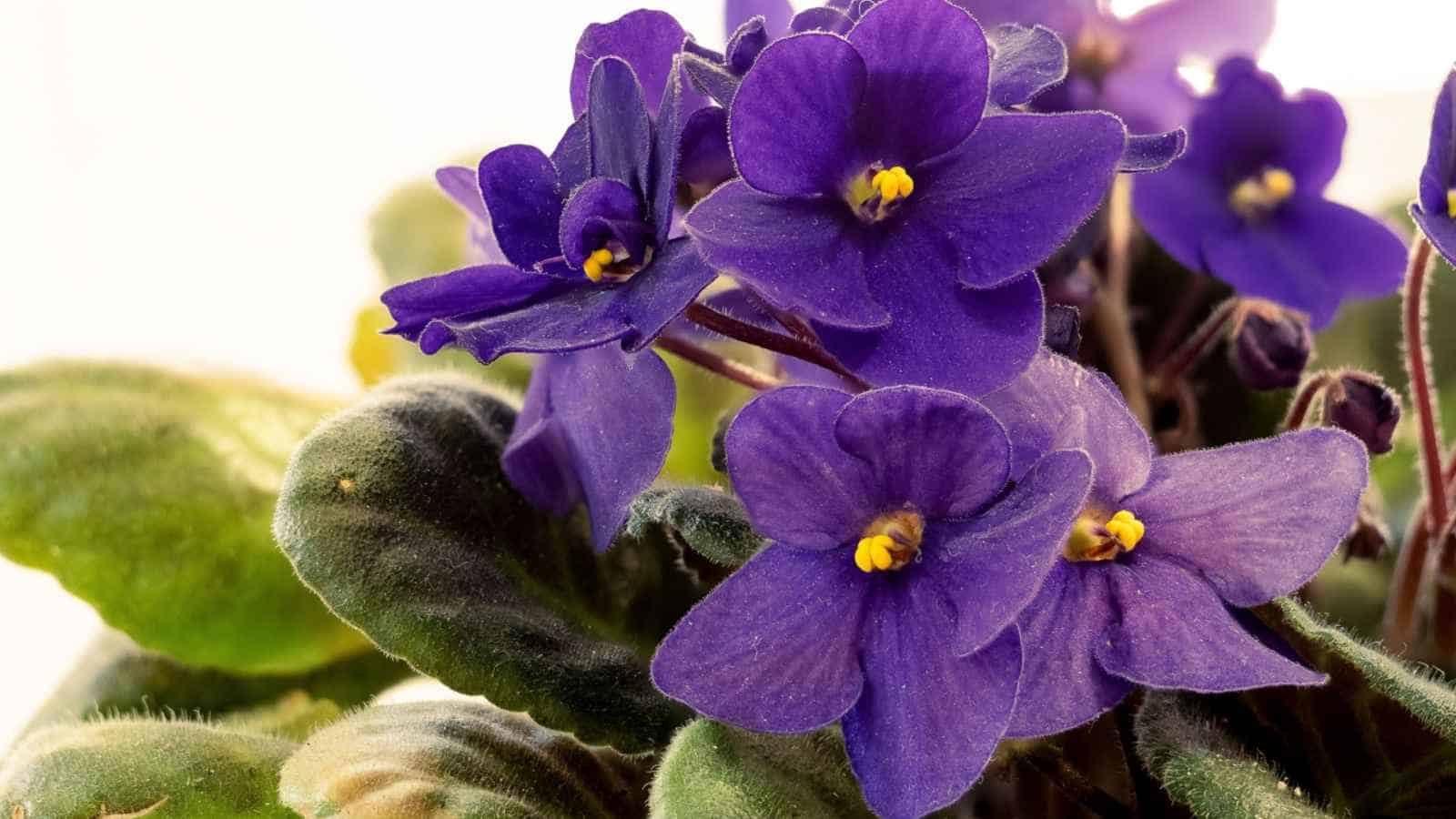
- Botanical Name: Saintpaulia
- Mature Size: 6 to 12 inches tall
- Bloom Time: Throughout the year
- Leaf Color: Green, often with a fuzzy texture
- Flower Color: Various vibrant hues
- Light: Bright, indirect light
- Soil Needs: Well-draining, slightly acidic soil
- USDA Hardiness Zones: 11 to 12
Saintpaulia, or African violets, are known for their compact size and vibrant, delicate flowers. Adaptable to rainforest conditions, they thrive in the filtered light of the forest floor.
Blue Taro (Colocasia esculenta)
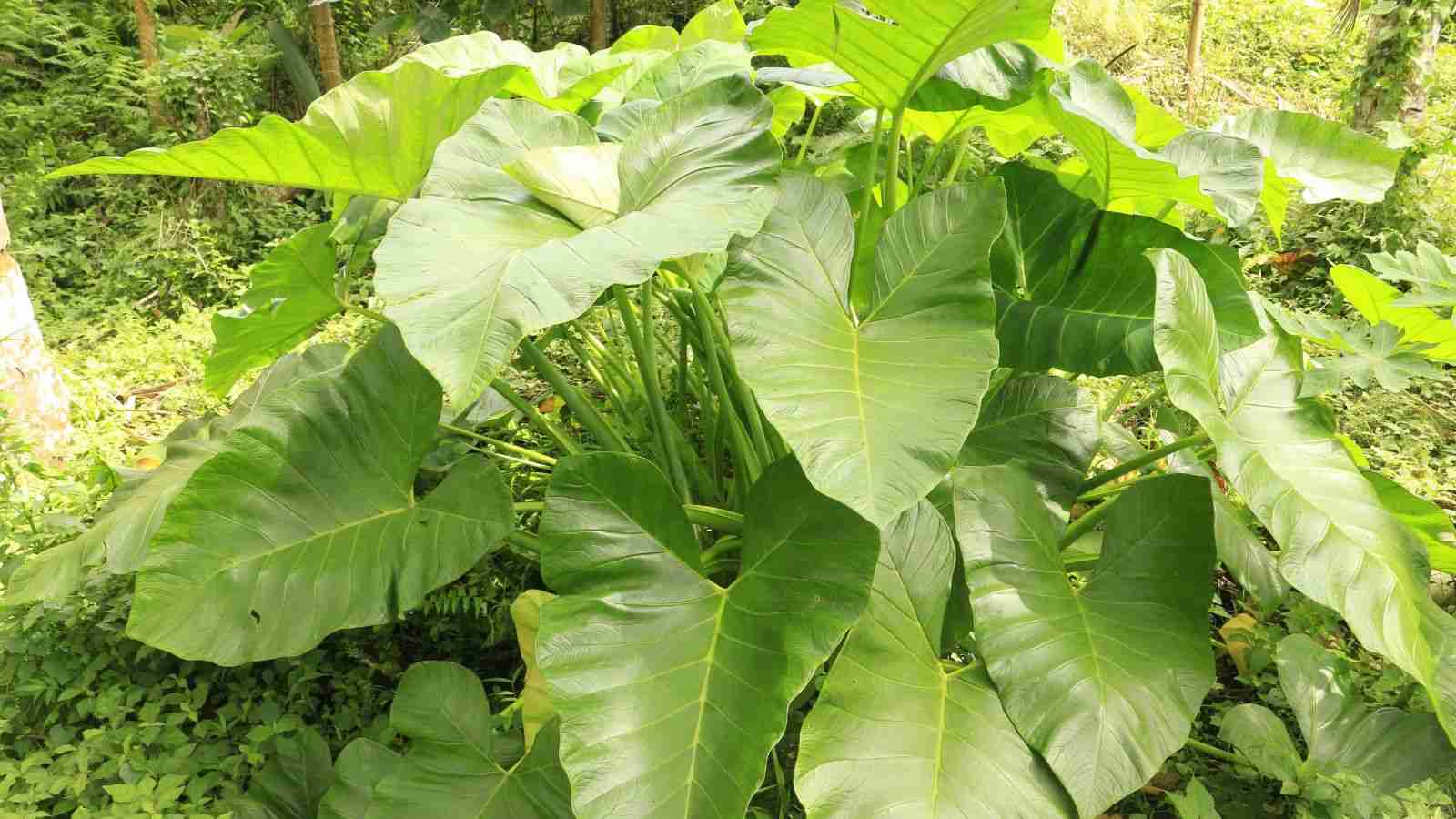
- Botanical Name:Colocasia esculenta
- Mature Size: Up to 6 feet tall
- Bloom Time: Late spring to summer
- Leaf Color: Green to bluish hues
- Light: Partial shade to full sun
- Soil Needs: Moist, well-draining soil
- USDA Hardiness Zones: 8 to 10
Colocasia esculenta, or blue taro, is a starchy root vegetable plant with large, heart-shaped leaves. Well-adapted to rainforest environments, it plays a role in both the ecology and traditional agriculture of these regions.
Cycad (Cycadaceae)
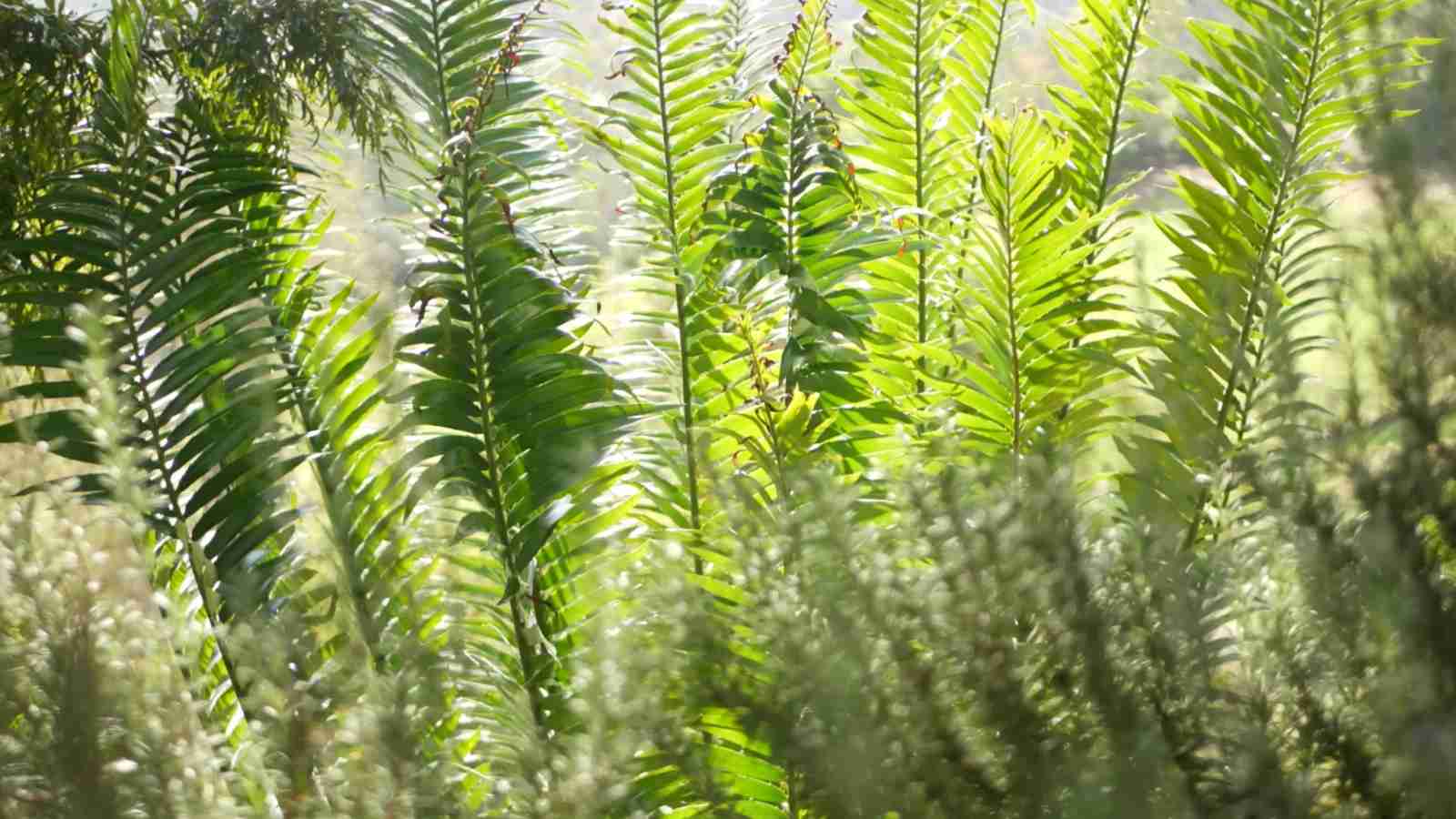
- Botanical Name: Cycadaceae
- Mature Size: Varies by species
- Bloom Time: Infrequent and not the main feature
- Leaf Color: Green, often with a fern-like appearance
- Light: Bright, indirect light
- Soil Needs: Well-draining, sandy soil
- USDA Hardiness Zones: Varies
Cycadaceae, or cycads, are ancient seed plants with distinctive, palm-like foliage. Thriving in rainforests they contribute to the prehistoric charm of these ecosystems.
Monstera (Monstera deliciosa)

- Botanical Name:Monstera deliciosa
- Mature Size: Up to 10 feet tall indoors
- Bloom Time: Rarely flowers indoors
- Leaf Color: Dark green, fenestrated and split
- Flower Color: Inconspicuous
- Light: Bright, indirect light
- Soil Needs: Well-draining, fertile soil
- USDA Hardiness Zones: 10 to 12
Monstera deliciosa, the monstera, is a popular rainforest plant with iconic split leaves. It thrives in the understory, using its unique foliage to capture and optimize light for photosynthesis.
Pothos (Epipremnum aureum)

- Botanical Name: Epipremnum aureum
- Mature Size: Up to 10 feet
- Bloom Time: Rarely flowers indoors
- Leaf Color: Variegated green and yellow
- Flower Color: Inconspicuous
- Light: Indirect, low to bright light
- Soil Needs: Well-draining potting mix
- USDA Hardiness Zones: 10-12
Pothos, scientifically known as Epipremnum aureum, is a popular and versatile houseplant. Its heart-shaped, glossy leaves add a touch of greenery to any indoor space. Pothos thrives in a variety of light conditions and is known for its ability to purify indoor air. This adaptable plant is easy to care for and is an excellent choice for both novice and experienced plant enthusiasts.
Cocoa Tree (Theobroma cacao)
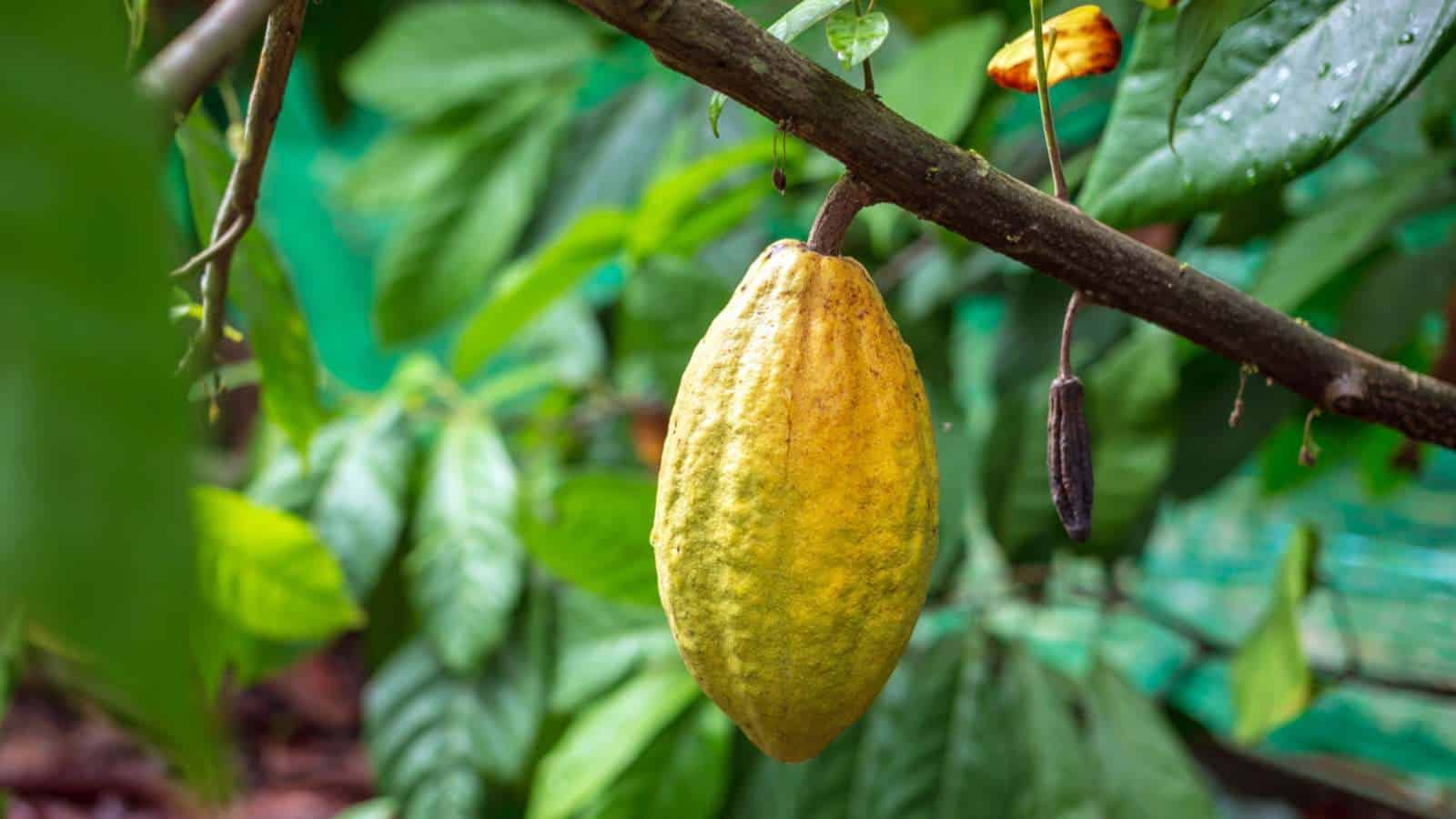
- Botanical Name: Theobroma cacao
- Mature Size: 15 to 30 feet
- Bloom Time: Year-round
- Leaf Color: Dark green
- Flower Color: Pink or white
- Light: Filtered sunlight
- Soil Needs: Well-draining, rich soil
- USDA Hardiness Zones: 11-12
The Cocoa Tree, scientifically referred to as Theobroma cacao, is renowned for its role in chocolate production. This tropical tree produces cocoa beans, which are the primary ingredient in chocolate. The dark green foliage and small pink or white flowers make it a visually appealing addition to tropical rainforests. Its fruit pods contain seeds that are processed to create cocoa products.
Vanilla Orchid (Vanilla planifolia)
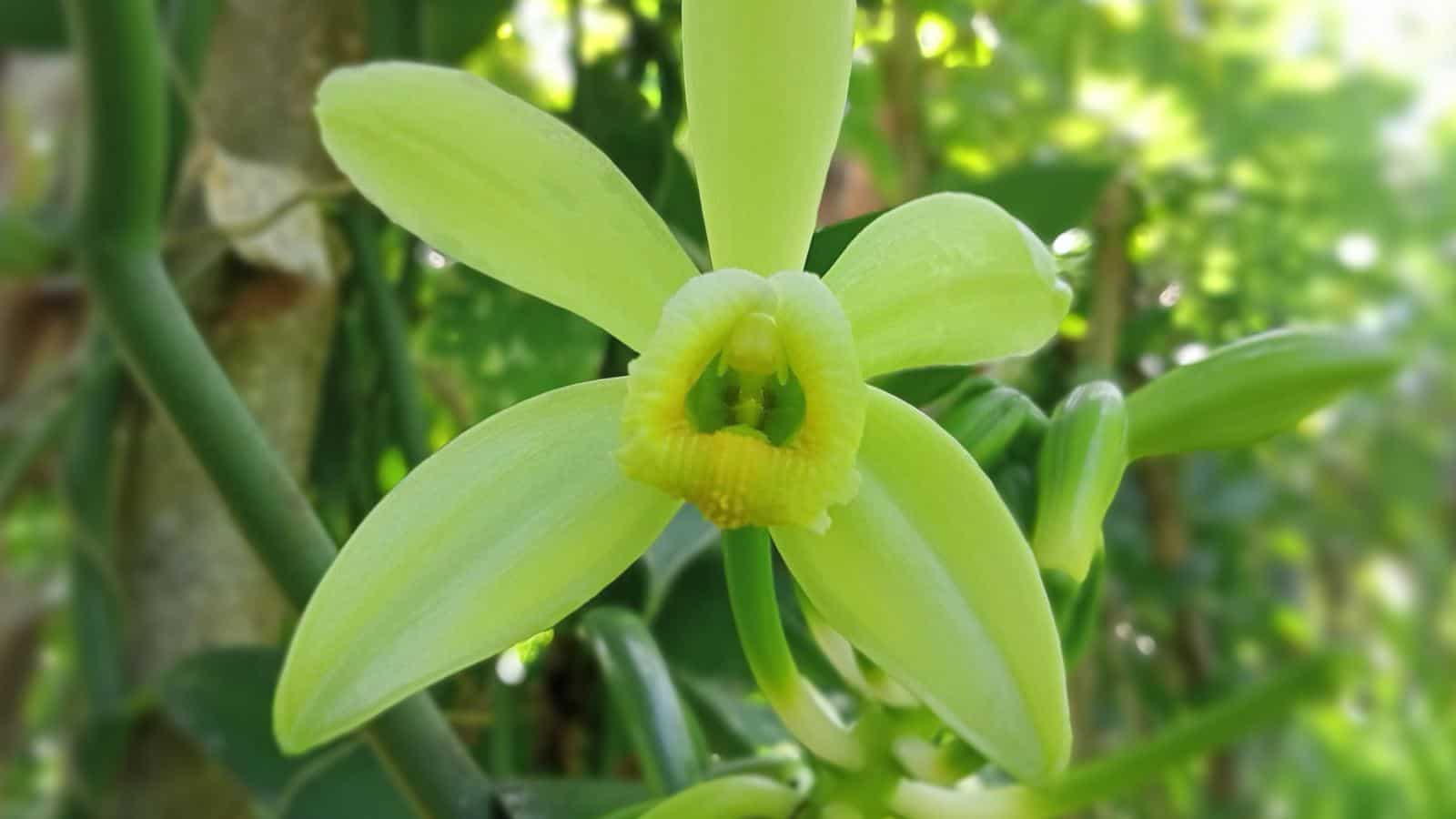
- Botanical Name: Vanilla planifolia
- Mature Size: 10 to 20 feet
- Bloom Time: Spring to early summer
- Leaf Color: Green
- Flower Color: Creamy yellow
- Light: Bright, indirect light
- Soil Needs: Well-draining orchid mix
- USDA Hardiness Zones: 10-12
The Vanilla Orchid, scientifically known as Vanilla planifolia, is the source of vanilla flavoring. This climbing orchid produces fragrant, creamy yellow flowers, which eventually give rise to vanilla beans. Growing in the rainforest understory, its vines cling to tree trunks. Vanilla Orchids require a humid environment and filtered sunlight, making them a fascinating addition to tropical ecosystems.
Moss Fern (Selaginella)
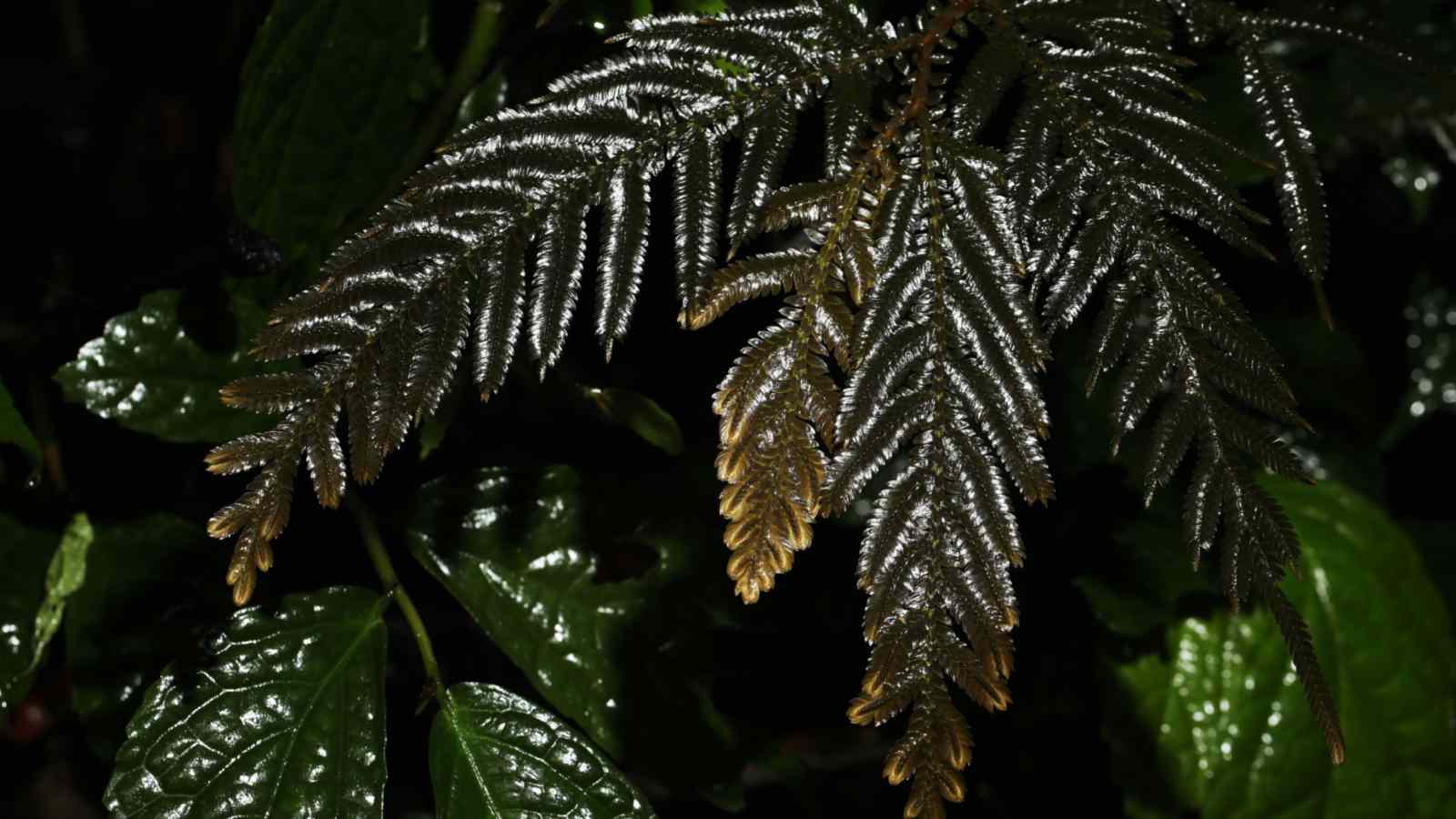
- Botanical Name: Selaginella
- Mature Size: Varies by species
- Bloom Time: Non-flowering
- Leaf Color: Green
- Flower Color: Non-flowering
- Light: Low to moderate light
- Soil Needs: Well-draining, moist soil
- USDA Hardiness Zones: Varies by species
Moss Ferns, belonging to the Selaginella genus, are primitive plants that resemble ferns but are not true ferns. These small, evergreen plants are well-adapted to humid rainforest environments, often carpeting the forest floor. Their delicate, lacy foliage and ability to tolerate low light conditions make Moss Ferns an enchanting addition to shaded garden areas.
Banana Plant (Musa)
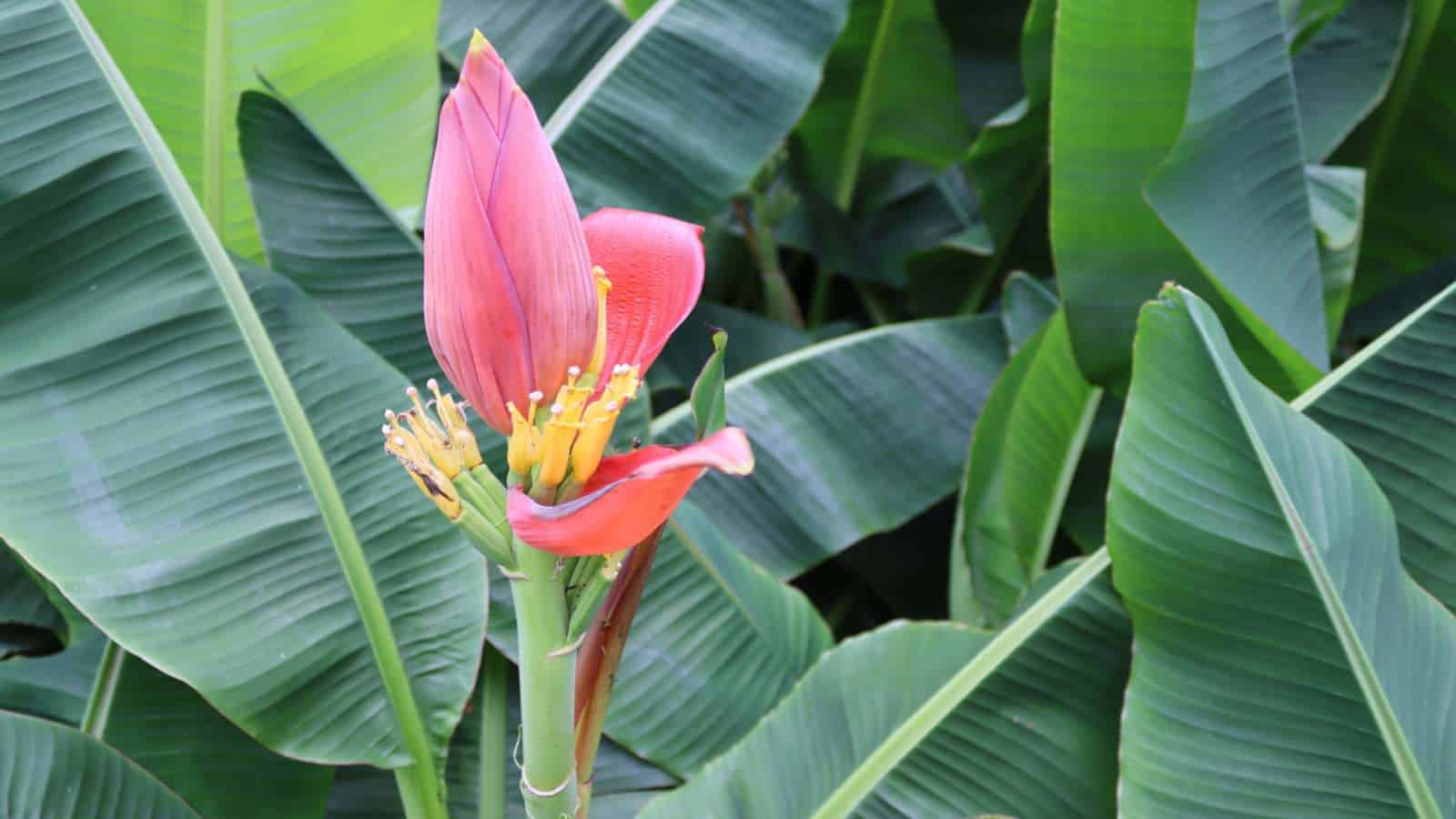
- Botanical Name: Musa
- Mature Size: 6 to 20 feet
- Bloom Time: Year-round
- Leaf Color: Green to reddish-purple
- Flower Color: Varies by species
- Light: Full to partial sunlight
- Soil Needs: Well-draining, fertile soil
- USDA Hardiness Zones: 9-11
Banana Plants, grouped under the Musa genus, are iconic tropical plants with large, paddle-shaped leaves and clusters of hanging fruits. With year-round blooming, these plants are a staple in tropical rainforests. They are not only valued for their fruit but also for their large, ornamental leaves that provide shelter for various rainforest creatures.
African Rubber Tree (Ficus elastica)
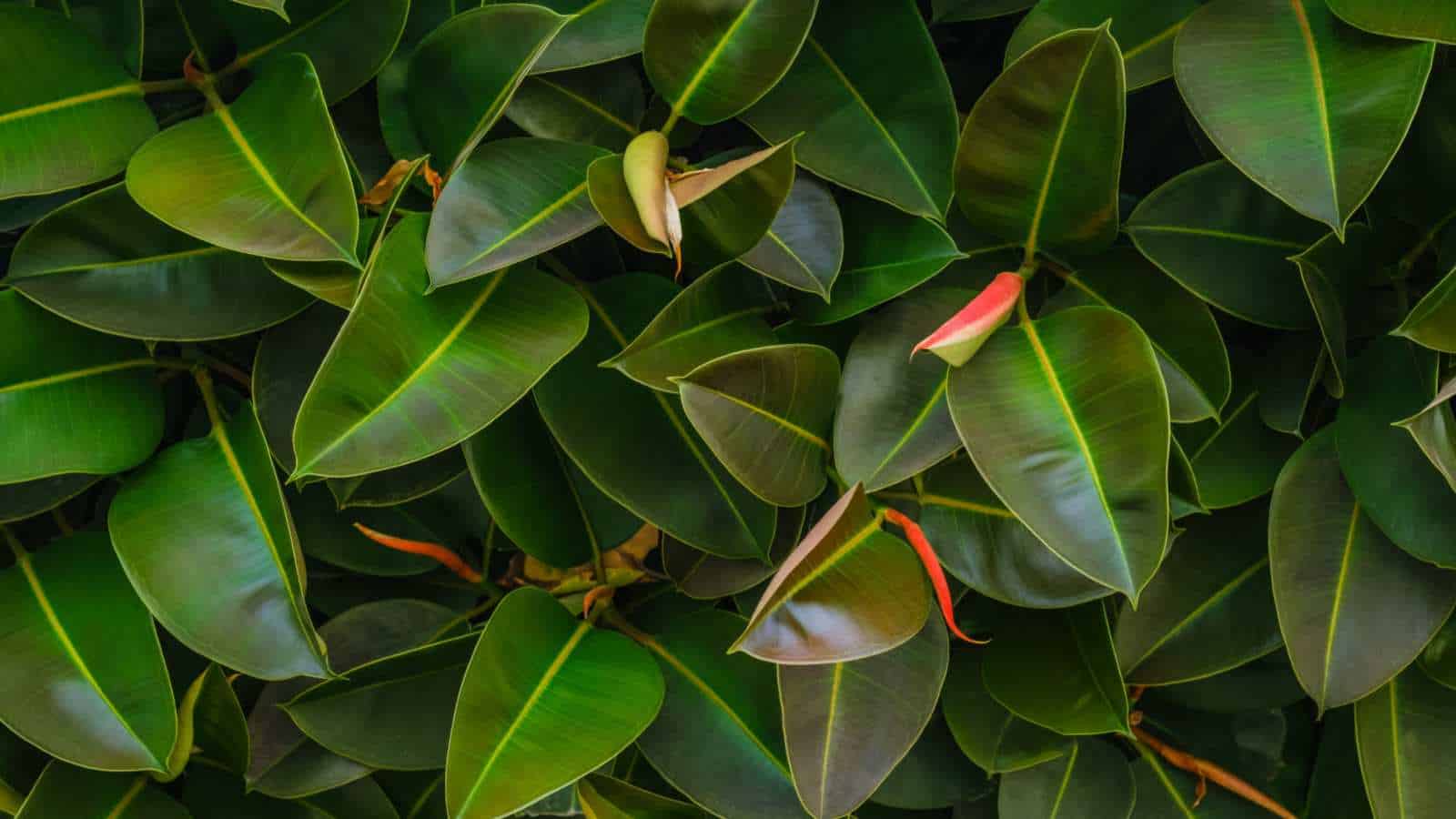
- Botanical Name: Ficus elastica
- Mature Size: Up to 100 feet in the wild, smaller indoors
- Bloom Time: Rarely flowers indoors
- Leaf Color: Dark green, and burgundy varieties available
- Flower Color: Inconspicuous
- Light: Bright, indirect light
- Soil Needs: Well-draining potting mix
- USDA Hardiness Zones: 10-12
The African Rubber Tree, scientifically known as Ficus elastica, is a popular houseplant appreciated for its attractive, broad leaves. In its native habitat, it can grow into a large tree. The dark green foliage and low-maintenance nature of the African Rubber Tree make it a favorite among indoor plant enthusiasts, contributing to the aesthetic appeal of homes and offices.
Red Ginger (Alpinia purpurata)
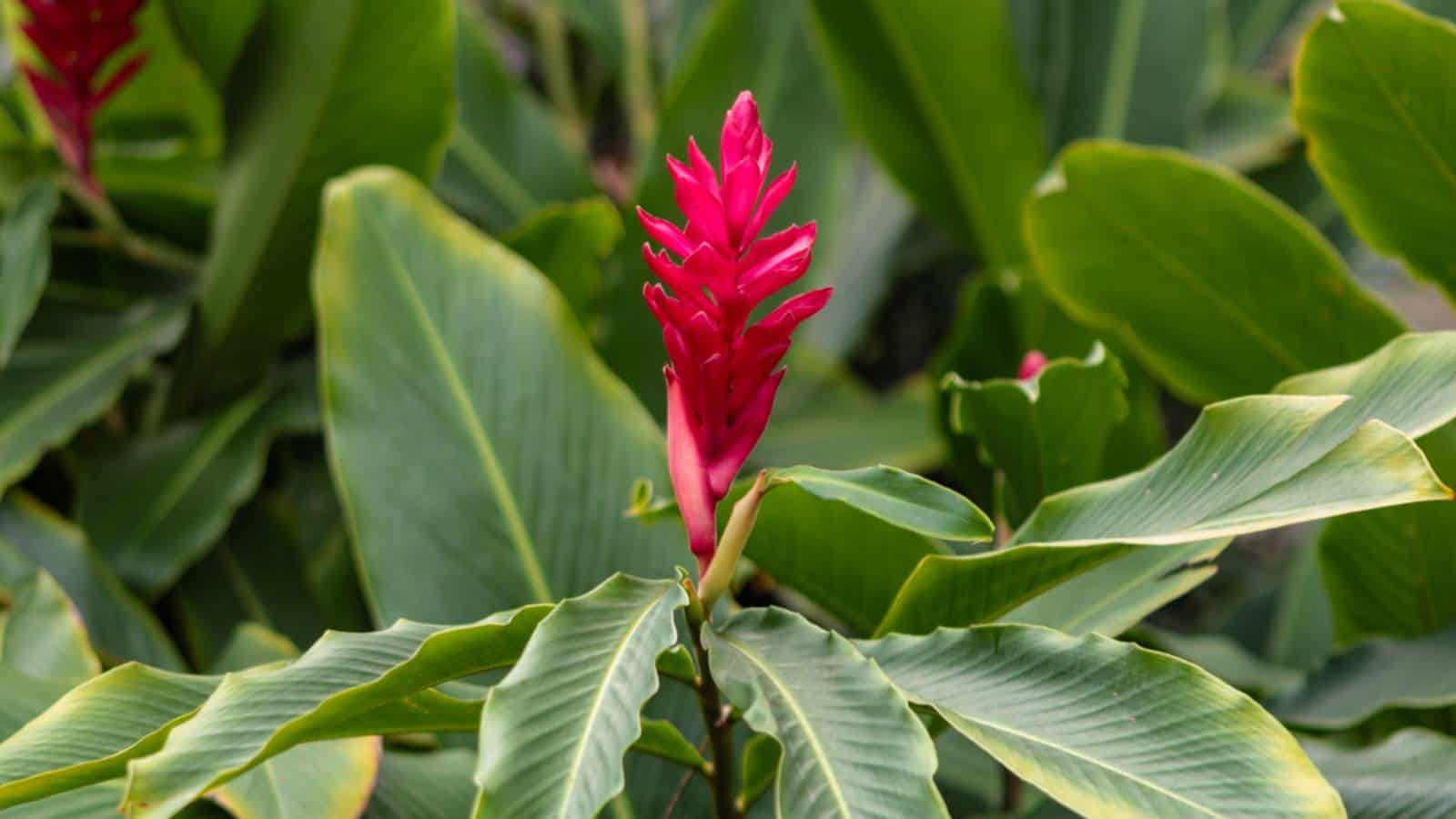
- Botanical Name: Alpinia purpurata
- Mature Size: 6 to 15 feet
- Bloom Time: Year-round
- Leaf Color: Green
- Flower Color: Red, pink, white, or orange
- Light: Partial to full sunlight
- Soil Needs: Well-draining, fertile soil
- USDA Hardiness Zones: 10-12
Red Ginger, scientifically known as Alpinia purpurata, is a tropical flowering plant known for its striking inflorescence. The red, pink, white, or orange cone-like flowers are surrounded by vibrant bracts, adding a splash of color to rainforest understories. Red Ginger is appreciated not only for its ornamental value but also for its cultural significance in traditional medicine and rituals.
Sundew (Drosera)
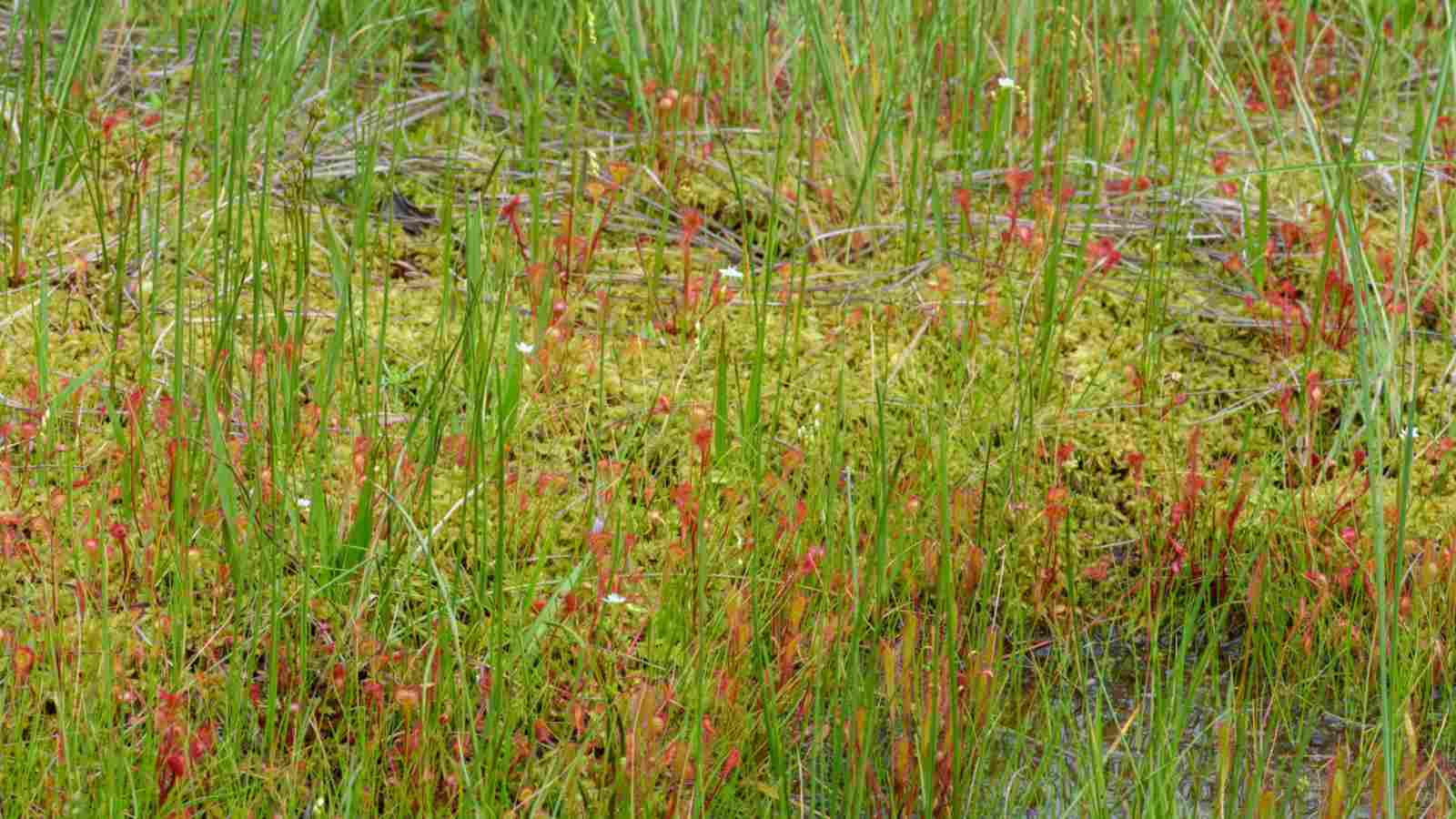
- Botanical Name: Drosera
- Mature Size: Varies by species
- Bloom Time: Spring to summer
- Leaf Color: Green to red
- Flower Color: White or pink
- Light: Full sunlight
- Soil Needs: Acidic, nutrient-poor soil
- USDA Hardiness Zones: Varies by species
Sundews, belonging to the Drosera genus, are carnivorous plants found in nutrient-poor soils. These fascinating plants capture insects with their sticky, glandular tentacles. Sundews are characterized by their spiral arrangement of leaves, each adorned with glistening droplets that attract and digest prey. Their unique adaptation to nutrient-poor soils makes them intriguing components of the rainforest ecosystem.
Lady Slipper Orchid (Cypripedioideae)
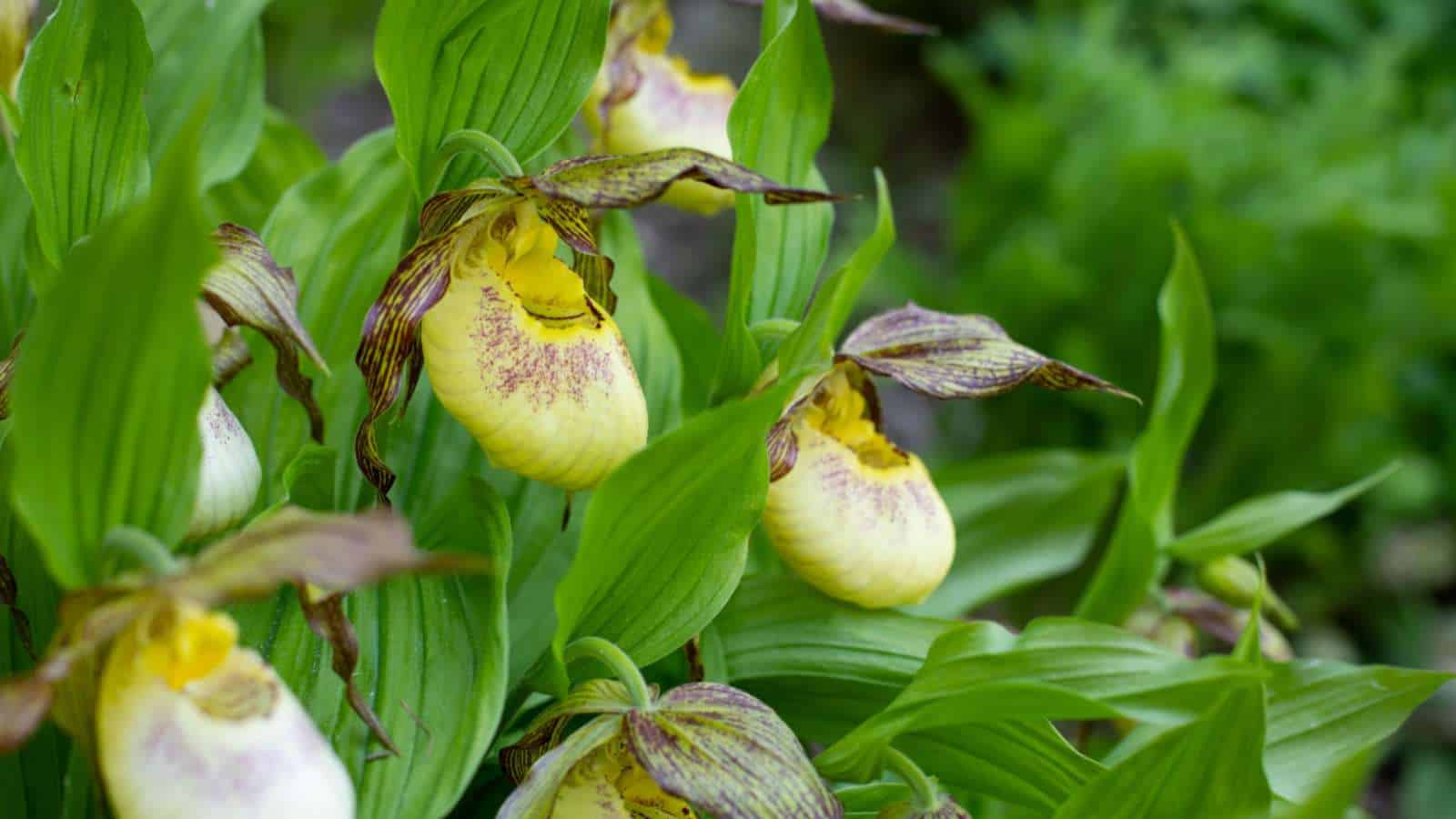
- Botanical Name: Cypripedioideae
- Mature Size: 6 inches to 2 feet
- Bloom Time: Spring to summer
- Leaf Color: Green
- Flower Color: Various, often pink or yellow
- Light: Filtered sunlight
- Soil Needs: Well-draining orchid mix
- USDA Hardiness Zones: Varies by species
Lady Slipper Orchids, part of the Cypripedioideae subfamily, are renowned for their unique slipper-shaped pouches. These orchids are adapted to the rainforest understory, where they thrive in shaded conditions. Lady Slippers often have intricate patterns and vibrant colors, attracting pollinators. Their captivating appearance and specialized reproductive strategies make them sought-after by orchid enthusiasts.
Jade Vine (Strongylodon macrobotrys)
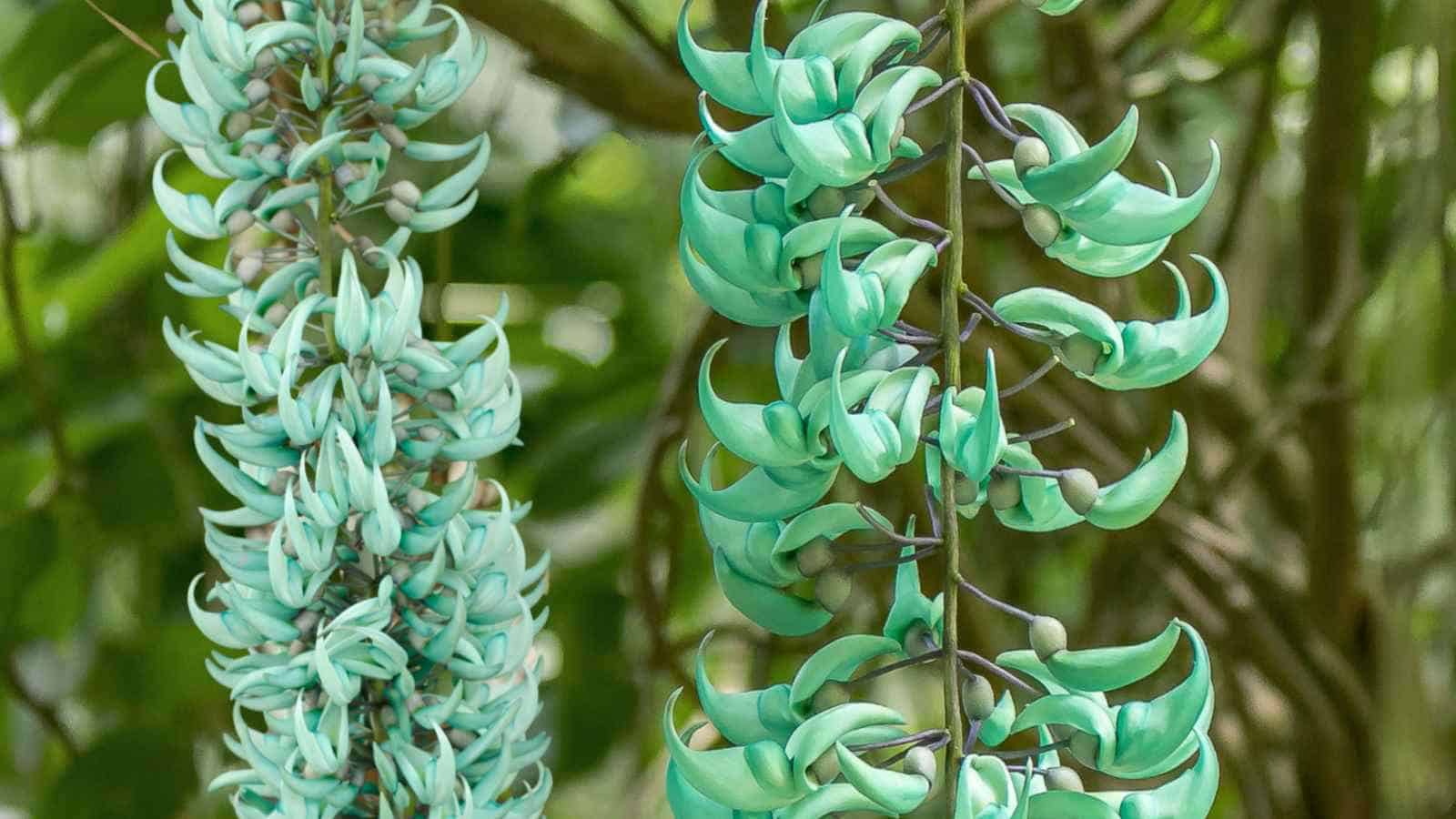
- Botanical Name: Strongylodon macrobotrys
- Mature Size: Up to 70 feet
- Bloom Time: Spring to summer
- Leaf Color: Green
- Flower Color: Turquoise blue to green
- Light: Full sunlight
- Soil Needs: Well-draining soil
- USDA Hardiness Zones: 10-11
The Jade Vine, scientifically referred to as Strongylodon macrobotrys, is a climbing vine with cascading clusters of turquoise blue to green flowers. Native to the Philippines, it is a rare and exotic plant. The long, hanging inflorescences make the Jade Vine a breathtaking sight in tropical rainforests. This plant’s unique flower color and form contribute to its allure and desirability among collectors.
Lianas
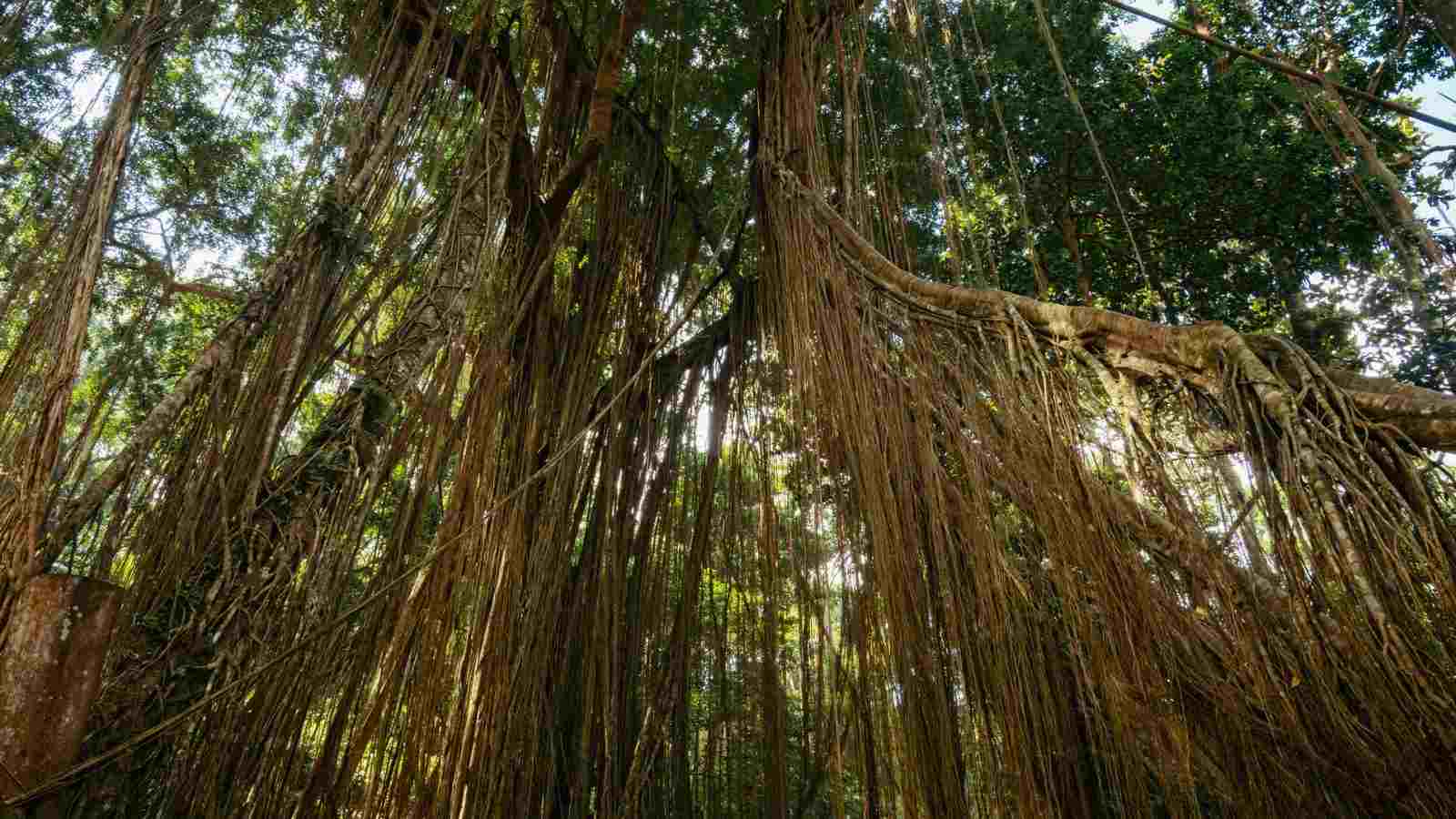
- Botanical Name: Varies by species
- Mature Size: Varies by species
- Bloom Time: Varies by species
- Leaf Color: Green
- Flower Color: Varies by species
- Light: Full sunlight
- Soil Needs: Well-draining soil
- USDA Hardiness Zones: Varies by species
Lianas are climbing woody vines found in tropical rainforests, playing a crucial role in the vertical structure of these ecosystems. They often wrap around trees, utilizing them for support. With a diverse range of species, lianas contribute to the intricate and layered architecture of the rainforest, serving as vital connectors between the different levels of the forest.
Strangler Figs
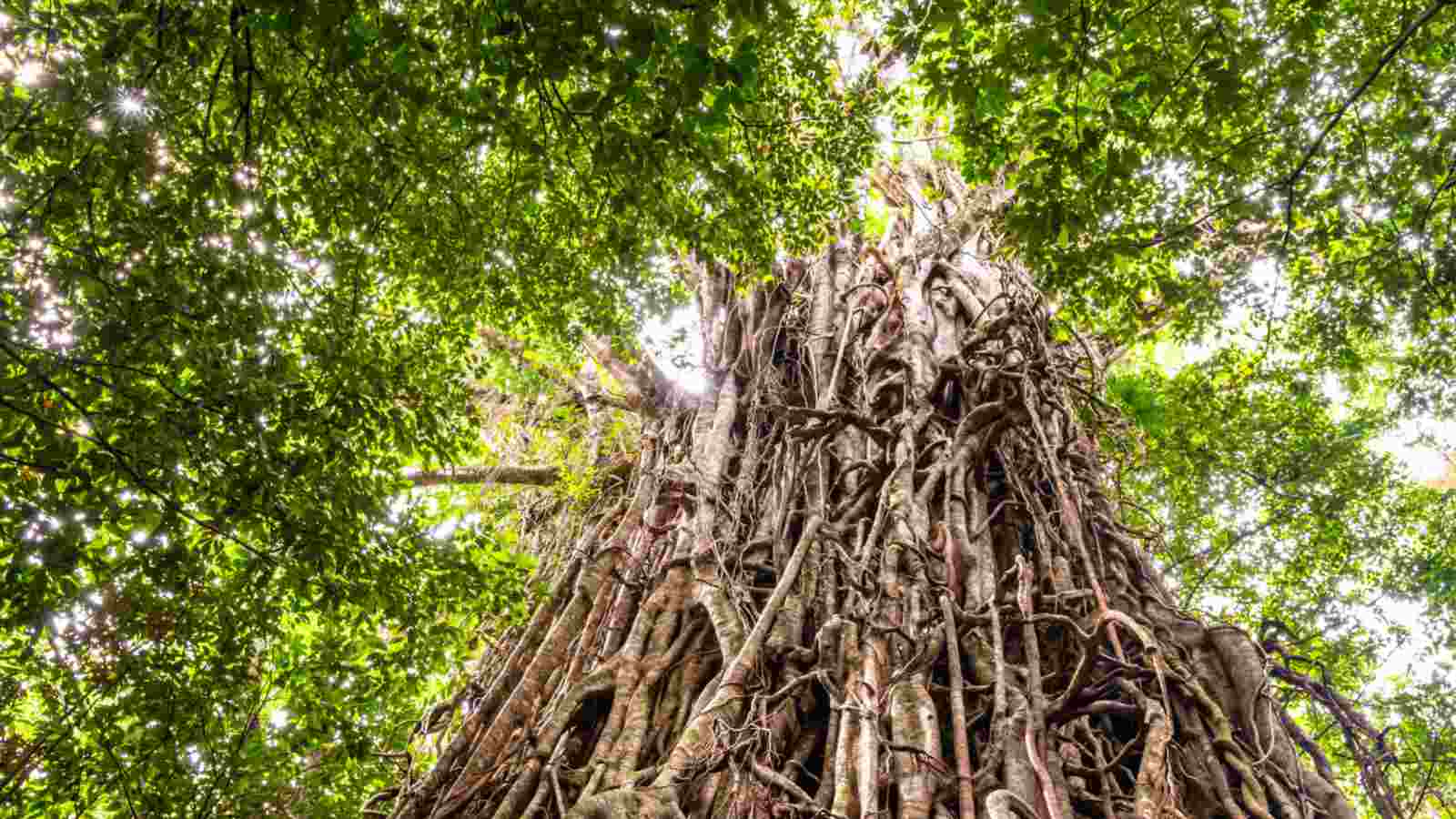
- Botanical Name: Varies by species
- Mature Size: Up to 100 feet
- Bloom Time: Varies by species
- Leaf Color: Green
- Flower Color: Inconspicuous
- Light: Full sunlight to partial shade
- Soil Needs: Well-draining soil
- USDA Hardiness Zones: Varies by species
Strangler Figs are remarkable plants that begin their life as epiphytes high in the canopy. As they grow, their roots extend downward, surrounding and eventually strangling their host tree. The host tree often dies, leaving behind a hollow interior. Strangler Figs play a crucial ecological role by contributing to the diversity of microhabitats within the rainforest.
Monkey Brush Vine (Combretum rotundifolium)
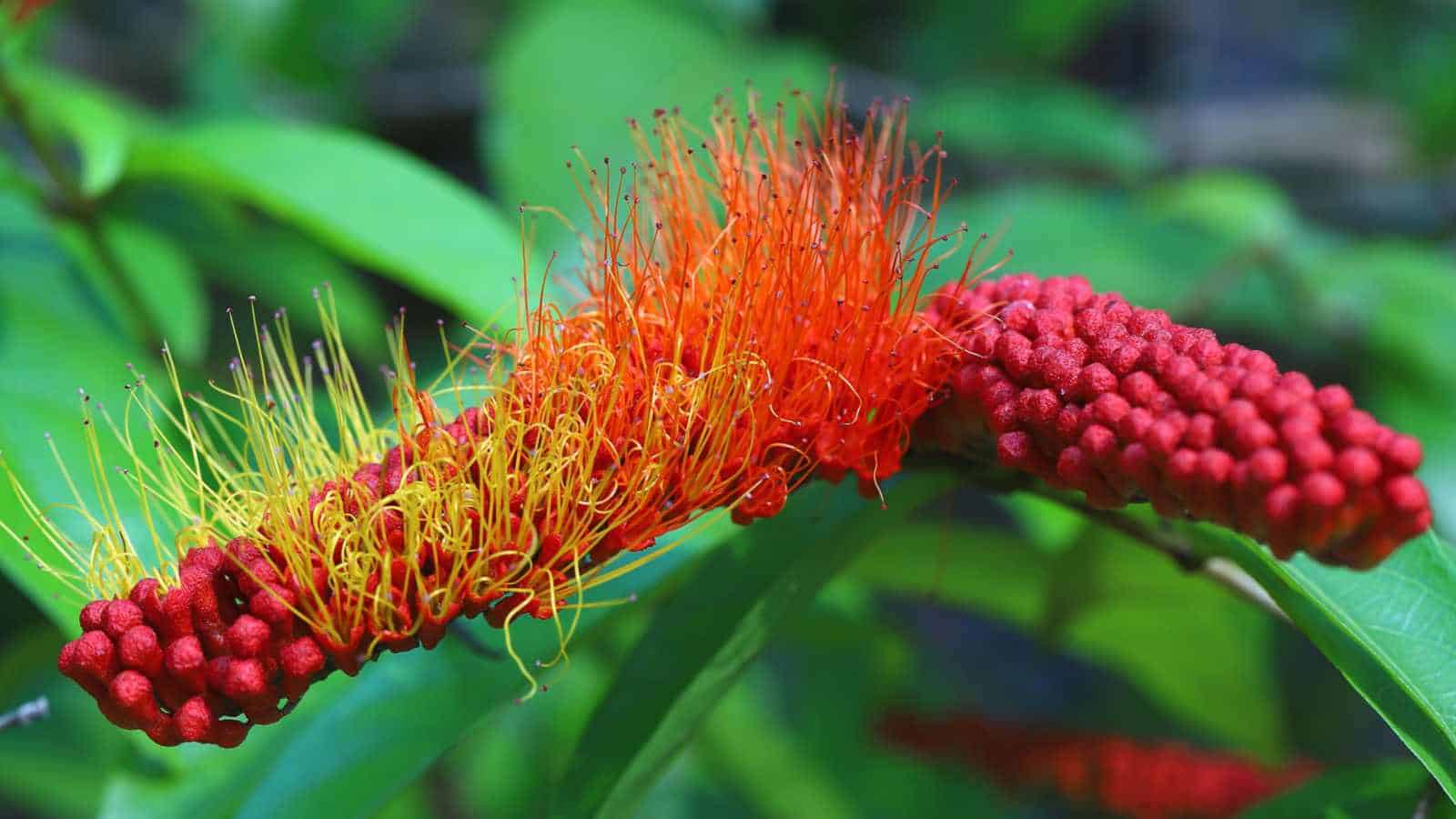
- Botanical Name: Combretum rotundifolium
- Mature Size: Up to 30 feet
- Bloom Time: Spring to summer
- Leaf Color: Green
- Flower Color: Orange-red
- Light: Full sunlight to partial shade
- Soil Needs: Well-draining soil
- USDA Hardiness Zones: 10-11
Monkey Brush Vine, scientifically known as Combretum rotundifolium, is a tropical climbing plant with vibrant orange-red flower clusters resembling a monkey’s brush. These vines add a burst of color to the rainforest canopy. Well-adapted to climbing on various substrates, Monkey Brush Vines contribute to the biodiversity and aesthetic richness of tropical ecosystems.
Giant Water Lily (Victoria amazonica)
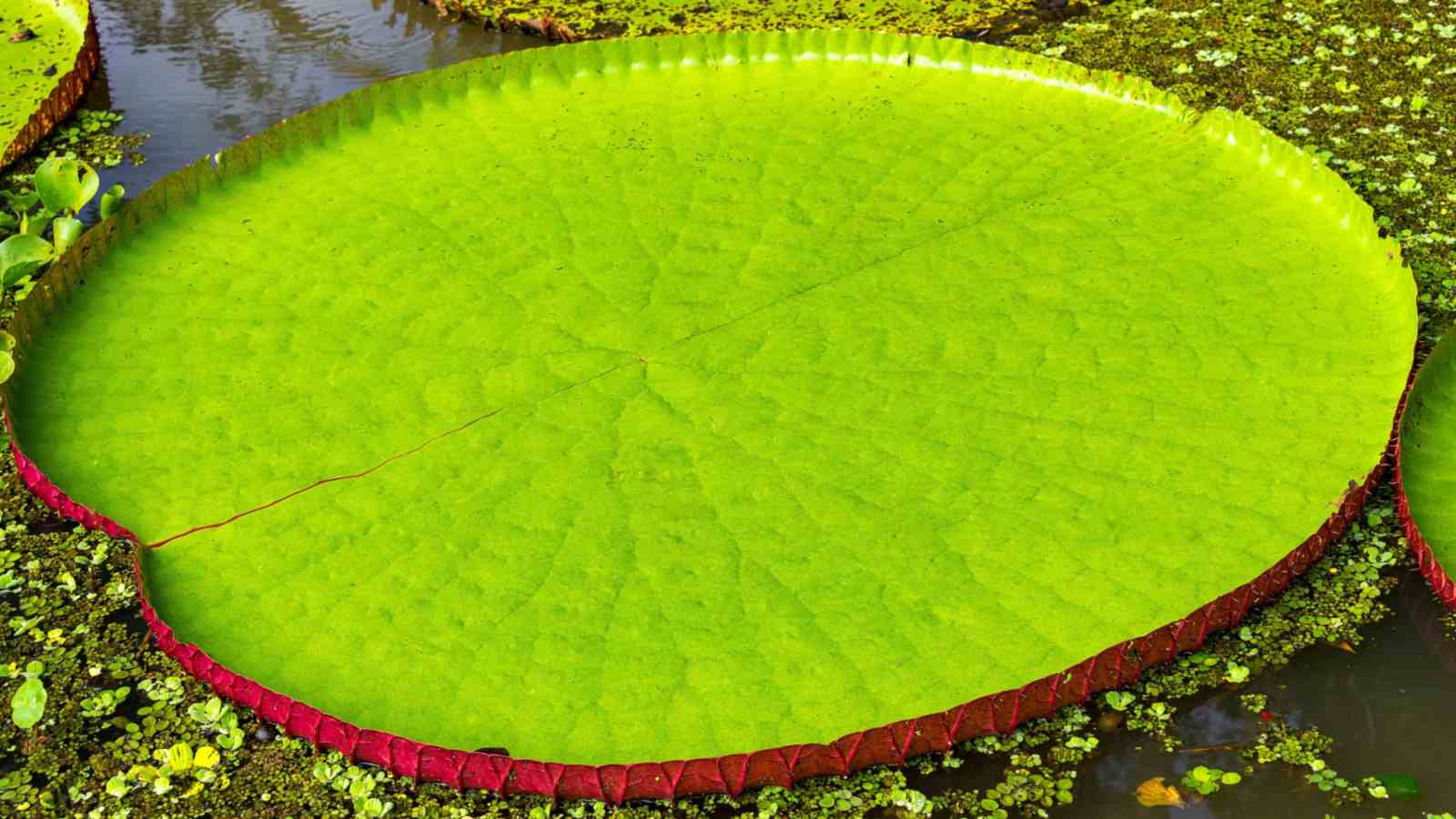
- Botanical Name: Victoria amazonica
- Mature Size: Leaves up to 10 feet in diameter
- Bloom Time: Night-blooming
- Leaf Color: Green
- Flower Color: White
- Light: Full sunlight
- Soil Needs: Rich, muddy substrate
- USDA Hardiness Zones: 10-12
The Giant Water Lily, scientifically referred to as Victoria Amazonica, is an iconic aquatic plant with enormous floating leaves. Native to the Amazon River basin, its large leaves provide shade for aquatic life. The night-blooming flowers add to the plant’s allure, attracting pollinators in the moonlit waters of rainforest ponds and lakes.
Heliconia Flower

- Botanical Name: Heliconia spp.
- Mature Size: Varies by species
- Bloom Time: Year-round
- Leaf Color: Green
- Flower Color: Vibrant, often red or orange
- Light: Full sunlight to partial shade
- Soil Needs: Well-draining soil
- USDA Hardiness Zones: Varies by species
Heliconias, members of the Heliconia genus, are known for their striking and vibrant flowers that resemble lobster claws or bird-of-paradise blooms. These tropical plants thrive in the rainforest understory, adding color and drama to the diverse flora. Heliconia flowers also serve as a crucial food source for hummingbirds and other pollinators.
Coffee Plant (Coffea arabica)

- Botanical Name: Coffea arabica
- Mature Size: Up to 6 feet
- Bloom Time: Spring
- Leaf Color: Dark green
- Flower Color: White
- Light: Filtered sunlight
- Soil Needs: Well-draining, acidic soil
- USDA Hardiness Zones: 10-11
The Coffee Plant, scientifically known as Coffea arabica, is a tropical shrub famous for its coffee beans. In its natural habitat, it thrives in the shaded understory of rainforests. The dark green foliage and fragrant white flowers contribute to the plant’s visual appeal, while its economic importance makes it a significant component of tropical agriculture.
Rubber Tree (Hevea brasiliensis)
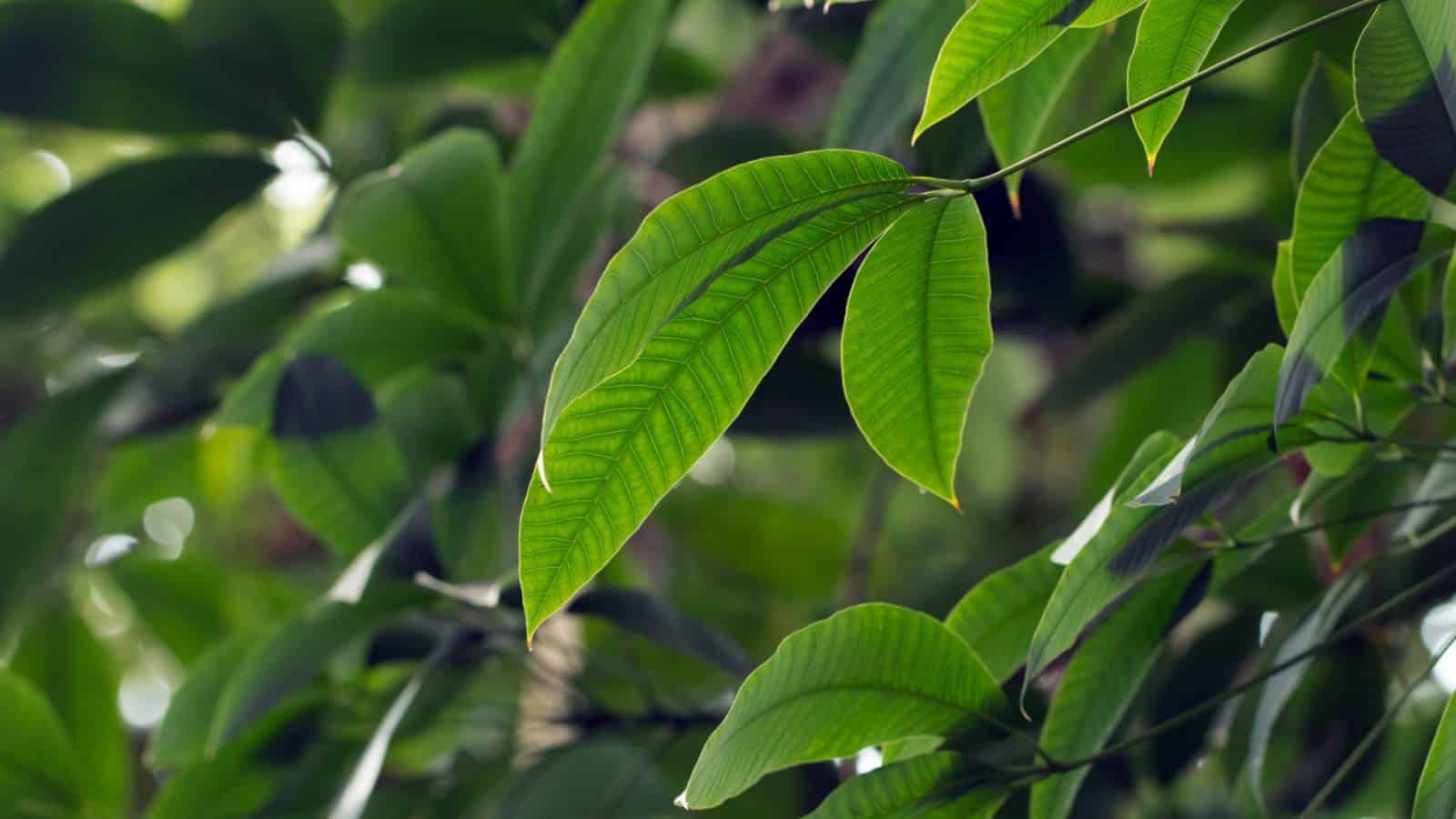
- Botanical Name: Hevea brasiliensis
- Mature Size: Up to 100 feet
- Bloom Time: Inconspicuous flowers
- Leaf Color: Dark green
- Flower Color: Inconspicuous
- Light: Full sunlight to partial shade
- Soil Needs: Well-draining soil
- USDA Hardiness Zones: 10-12
Hevea brasiliensis, the Rubber Tree, is a large evergreen tree valued for its latex production. Native to the Amazon rainforest, this tree has dark green leaves and inconspicuous flowers. Its economic significance and adaptability to various soil conditions make it a key species in tropical agroforestry systems.
Brazil Nut Tree (Bertholletia excelsa)

- Botanical Name: Bertholletia excelsa
- Mature Size: Up to 160 feet
- Bloom Time: Yellowish-white flowers
- Leaf Color: Dark green
- Flower Color: Yellowish-white
- Light: Full sunlight
- Soil Needs: Well-draining soil
- USDA Hardiness Zones: 10-12
The Brazil Nut Tree, scientifically referred to as Bertholletia excelsa, is an iconic rainforest tree known for its towering height and the large fruits containing Brazil nuts. This majestic tree contributes to the structural diversity of the rainforest canopy. Its reliance on specialized pollinators and seed dispersers underscores its ecological importance in tropical ecosystems.
Goliath Water Lilies
- Botanical Name: Nymphaea spp.
- Mature Size: Leaves up to 4 feet in diameter
- Bloom Time: Day-blooming
- Leaf Color: Green
- Flower Color: Various, often white or pink
- Light: Full sunlight
- Soil Needs: Rich, muddy substrate
- USDA Hardiness Zones: Varies by species
Goliath Water Lilies, belonging to the Nymphaea genus, are characterized by their large, floating leaves and showy, day-blooming flowers. These aquatic plants create a stunning display on the surface of rainforest water bodies, contributing to the overall biodiversity and beauty of the tropical landscape.
Other Plant Guides from Planet Natural:
50 Desert Plants – 10 Most Common + 40 Others with Photos and Facts
35 Best Terrarium Plants for a Beautiful and Low-Maintenance Display











